Financial Literacy and Awareness Study
VerifiedAdded on 2020/10/05
|20
|6343
|375
AI Summary
The provided study assignment focuses on the significance of financial literacy and awareness, drawing from multiple sources including academic journals, books, and online resources. It examines the role of financial literacy in managing debt, understanding retirement planning rules, and promoting economic stability. The assignment also touches upon the impact of corporate social responsibility on firm value and the awareness of Islamic banking products among Muslims. The study aims to provide a comprehensive overview of financial literacy research, with practical suggestions for improving financial knowledge and decision-making.
Contribute Materials
Your contribution can guide someone’s learning journey. Share your
documents today.
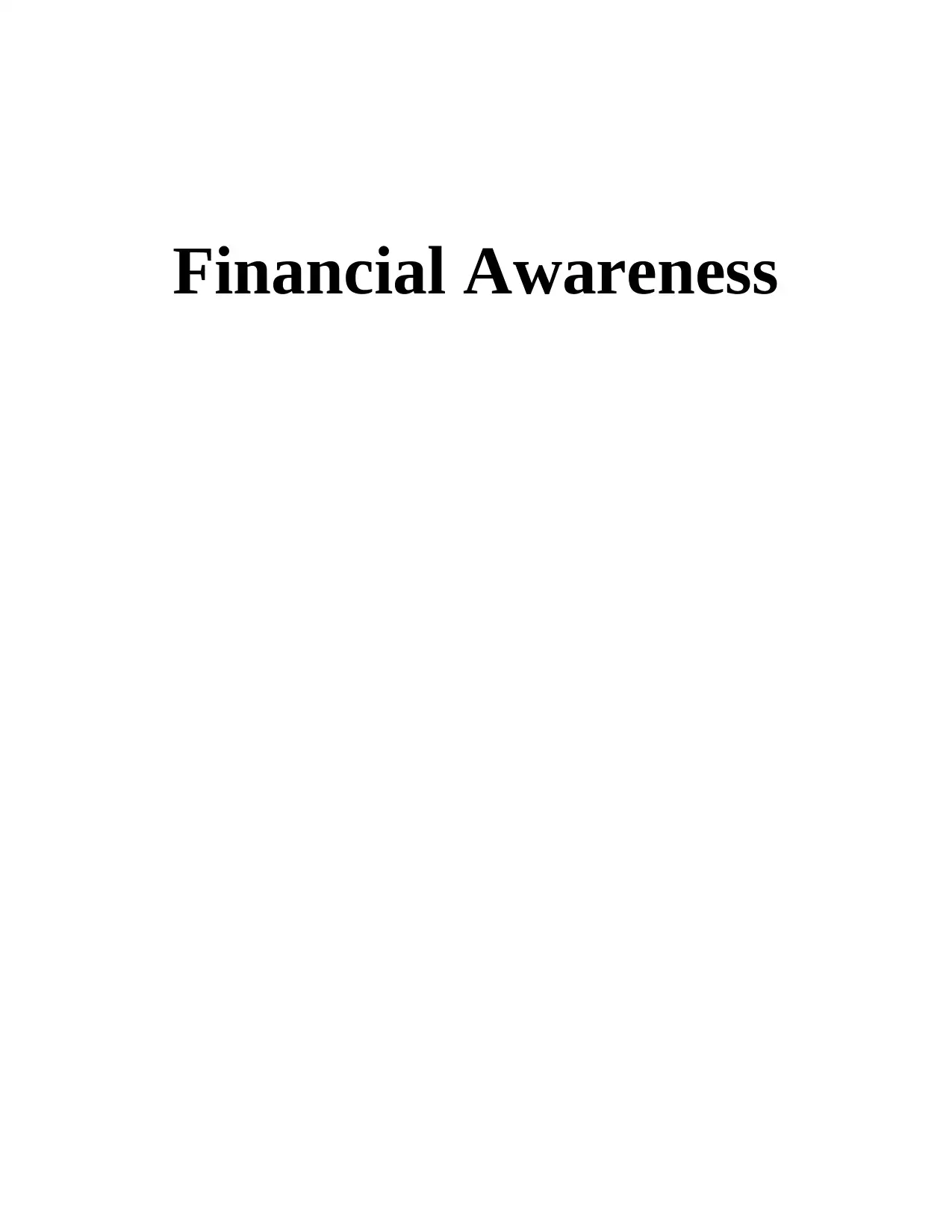
Financial Awareness
Secure Best Marks with AI Grader
Need help grading? Try our AI Grader for instant feedback on your assignments.

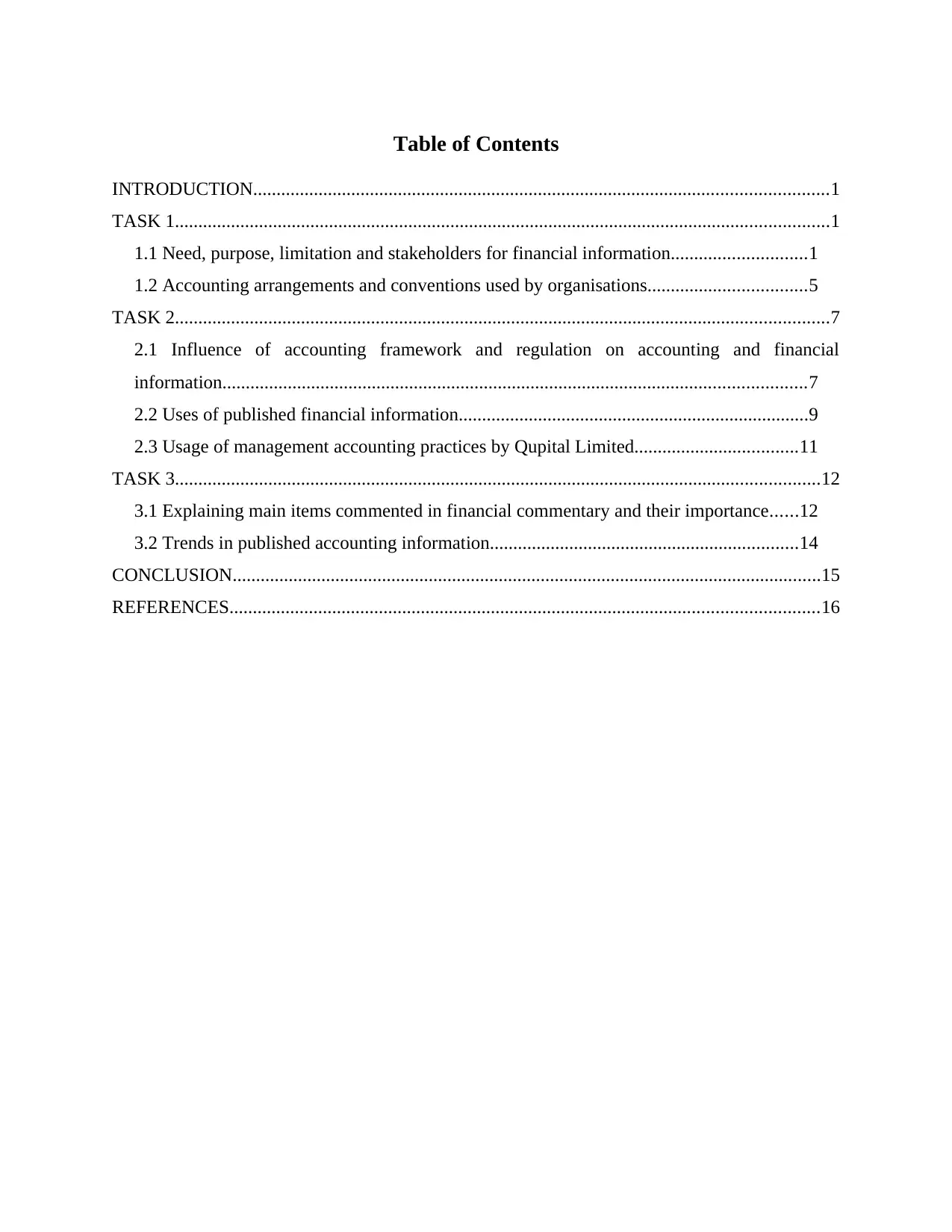
Table of Contents
INTRODUCTION...........................................................................................................................1
TASK 1............................................................................................................................................1
1.1 Need, purpose, limitation and stakeholders for financial information.............................1
1.2 Accounting arrangements and conventions used by organisations..................................5
TASK 2............................................................................................................................................7
2.1 Influence of accounting framework and regulation on accounting and financial
information.............................................................................................................................7
2.2 Uses of published financial information...........................................................................9
2.3 Usage of management accounting practices by Qupital Limited...................................11
TASK 3..........................................................................................................................................12
3.1 Explaining main items commented in financial commentary and their importance......12
3.2 Trends in published accounting information..................................................................14
CONCLUSION..............................................................................................................................15
REFERENCES..............................................................................................................................16
INTRODUCTION...........................................................................................................................1
TASK 1............................................................................................................................................1
1.1 Need, purpose, limitation and stakeholders for financial information.............................1
1.2 Accounting arrangements and conventions used by organisations..................................5
TASK 2............................................................................................................................................7
2.1 Influence of accounting framework and regulation on accounting and financial
information.............................................................................................................................7
2.2 Uses of published financial information...........................................................................9
2.3 Usage of management accounting practices by Qupital Limited...................................11
TASK 3..........................................................................................................................................12
3.1 Explaining main items commented in financial commentary and their importance......12
3.2 Trends in published accounting information..................................................................14
CONCLUSION..............................................................................................................................15
REFERENCES..............................................................................................................................16
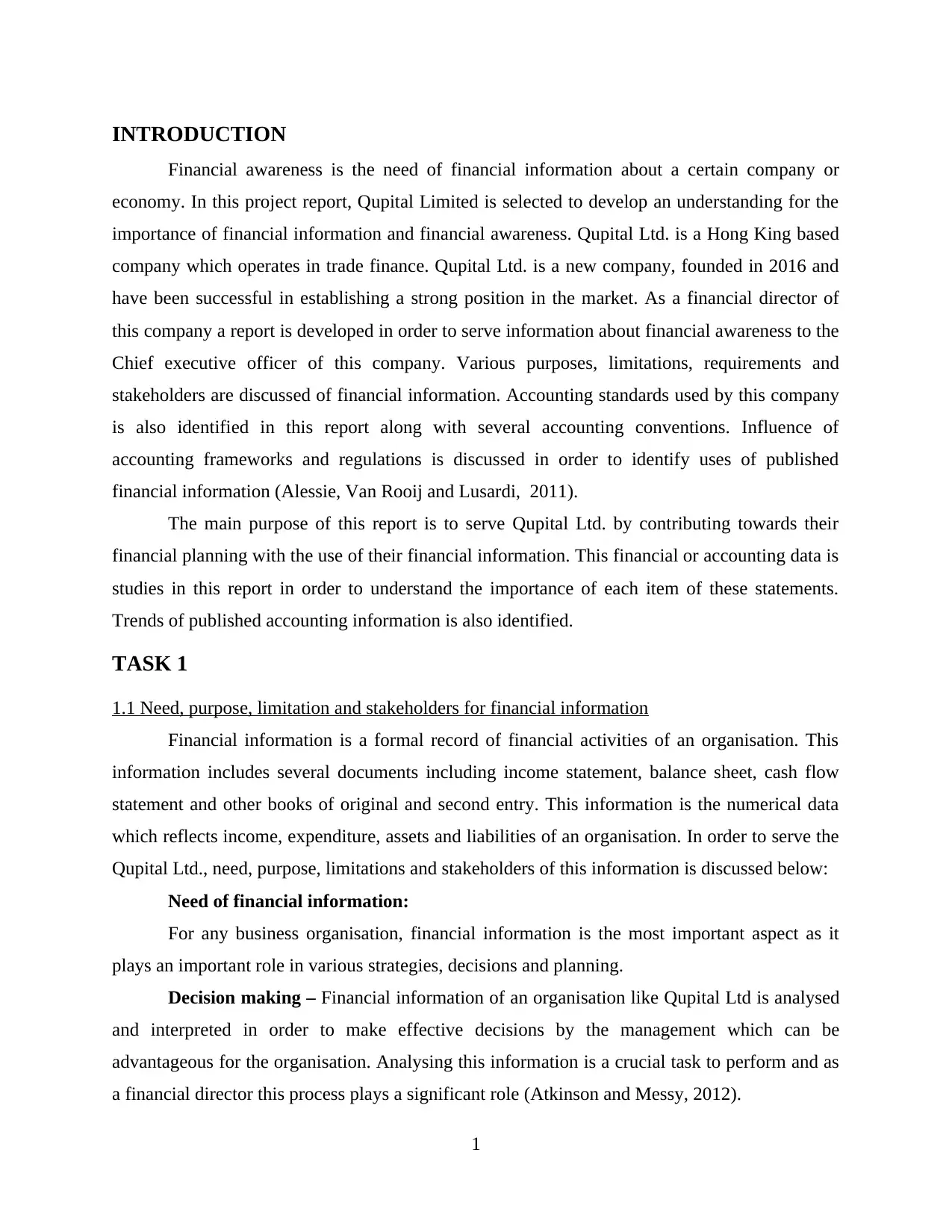
INTRODUCTION
Financial awareness is the need of financial information about a certain company or
economy. In this project report, Qupital Limited is selected to develop an understanding for the
importance of financial information and financial awareness. Qupital Ltd. is a Hong King based
company which operates in trade finance. Qupital Ltd. is a new company, founded in 2016 and
have been successful in establishing a strong position in the market. As a financial director of
this company a report is developed in order to serve information about financial awareness to the
Chief executive officer of this company. Various purposes, limitations, requirements and
stakeholders are discussed of financial information. Accounting standards used by this company
is also identified in this report along with several accounting conventions. Influence of
accounting frameworks and regulations is discussed in order to identify uses of published
financial information (Alessie, Van Rooij and Lusardi, 2011).
The main purpose of this report is to serve Qupital Ltd. by contributing towards their
financial planning with the use of their financial information. This financial or accounting data is
studies in this report in order to understand the importance of each item of these statements.
Trends of published accounting information is also identified.
TASK 1
1.1 Need, purpose, limitation and stakeholders for financial information
Financial information is a formal record of financial activities of an organisation. This
information includes several documents including income statement, balance sheet, cash flow
statement and other books of original and second entry. This information is the numerical data
which reflects income, expenditure, assets and liabilities of an organisation. In order to serve the
Qupital Ltd., need, purpose, limitations and stakeholders of this information is discussed below:
Need of financial information:
For any business organisation, financial information is the most important aspect as it
plays an important role in various strategies, decisions and planning.
Decision making – Financial information of an organisation like Qupital Ltd is analysed
and interpreted in order to make effective decisions by the management which can be
advantageous for the organisation. Analysing this information is a crucial task to perform and as
a financial director this process plays a significant role (Atkinson and Messy, 2012).
1
Financial awareness is the need of financial information about a certain company or
economy. In this project report, Qupital Limited is selected to develop an understanding for the
importance of financial information and financial awareness. Qupital Ltd. is a Hong King based
company which operates in trade finance. Qupital Ltd. is a new company, founded in 2016 and
have been successful in establishing a strong position in the market. As a financial director of
this company a report is developed in order to serve information about financial awareness to the
Chief executive officer of this company. Various purposes, limitations, requirements and
stakeholders are discussed of financial information. Accounting standards used by this company
is also identified in this report along with several accounting conventions. Influence of
accounting frameworks and regulations is discussed in order to identify uses of published
financial information (Alessie, Van Rooij and Lusardi, 2011).
The main purpose of this report is to serve Qupital Ltd. by contributing towards their
financial planning with the use of their financial information. This financial or accounting data is
studies in this report in order to understand the importance of each item of these statements.
Trends of published accounting information is also identified.
TASK 1
1.1 Need, purpose, limitation and stakeholders for financial information
Financial information is a formal record of financial activities of an organisation. This
information includes several documents including income statement, balance sheet, cash flow
statement and other books of original and second entry. This information is the numerical data
which reflects income, expenditure, assets and liabilities of an organisation. In order to serve the
Qupital Ltd., need, purpose, limitations and stakeholders of this information is discussed below:
Need of financial information:
For any business organisation, financial information is the most important aspect as it
plays an important role in various strategies, decisions and planning.
Decision making – Financial information of an organisation like Qupital Ltd is analysed
and interpreted in order to make effective decisions by the management which can be
advantageous for the organisation. Analysing this information is a crucial task to perform and as
a financial director this process plays a significant role (Atkinson and Messy, 2012).
1
Secure Best Marks with AI Grader
Need help grading? Try our AI Grader for instant feedback on your assignments.
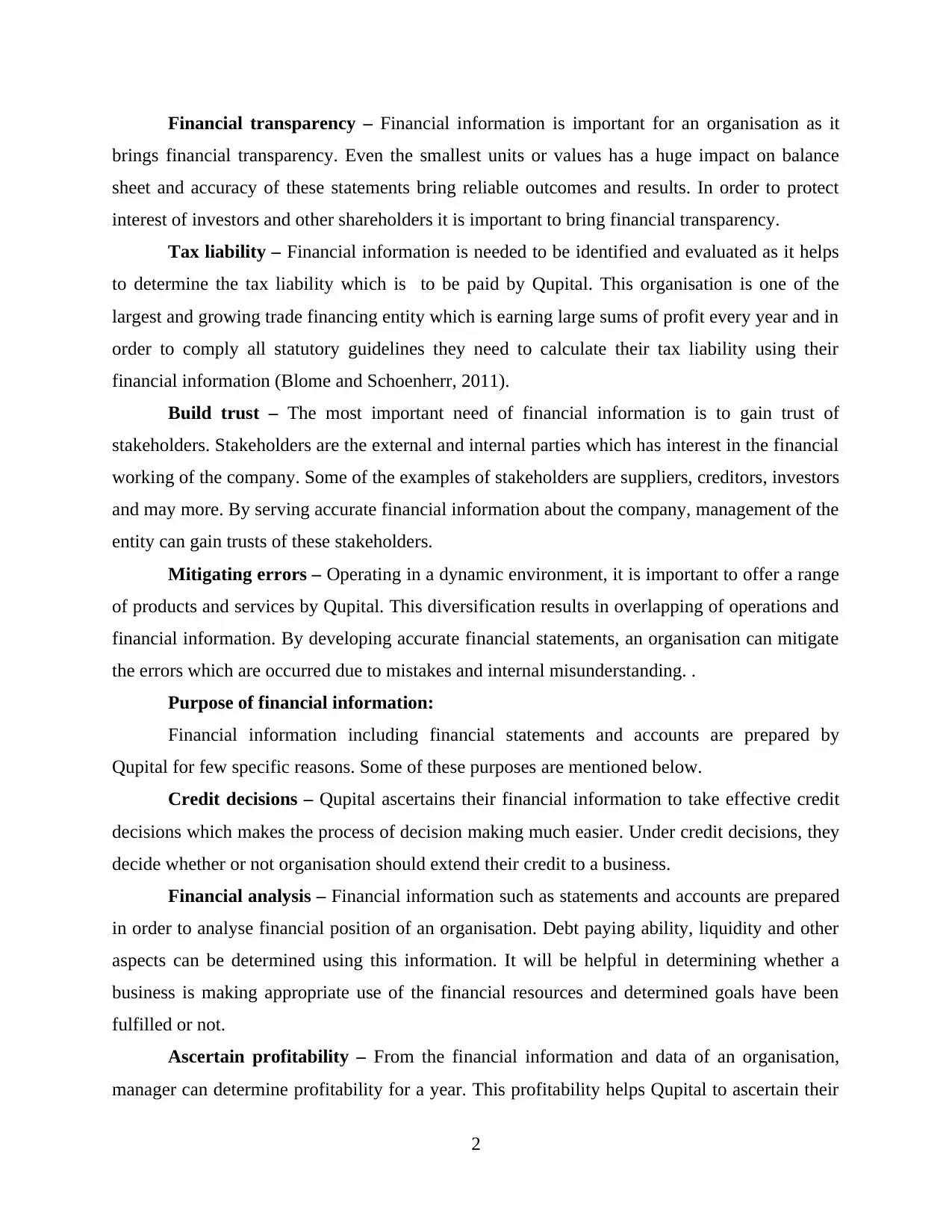
Financial transparency – Financial information is important for an organisation as it
brings financial transparency. Even the smallest units or values has a huge impact on balance
sheet and accuracy of these statements bring reliable outcomes and results. In order to protect
interest of investors and other shareholders it is important to bring financial transparency.
Tax liability – Financial information is needed to be identified and evaluated as it helps
to determine the tax liability which is to be paid by Qupital. This organisation is one of the
largest and growing trade financing entity which is earning large sums of profit every year and in
order to comply all statutory guidelines they need to calculate their tax liability using their
financial information (Blome and Schoenherr, 2011).
Build trust – The most important need of financial information is to gain trust of
stakeholders. Stakeholders are the external and internal parties which has interest in the financial
working of the company. Some of the examples of stakeholders are suppliers, creditors, investors
and may more. By serving accurate financial information about the company, management of the
entity can gain trusts of these stakeholders.
Mitigating errors – Operating in a dynamic environment, it is important to offer a range
of products and services by Qupital. This diversification results in overlapping of operations and
financial information. By developing accurate financial statements, an organisation can mitigate
the errors which are occurred due to mistakes and internal misunderstanding. .
Purpose of financial information:
Financial information including financial statements and accounts are prepared by
Qupital for few specific reasons. Some of these purposes are mentioned below.
Credit decisions – Qupital ascertains their financial information to take effective credit
decisions which makes the process of decision making much easier. Under credit decisions, they
decide whether or not organisation should extend their credit to a business.
Financial analysis – Financial information such as statements and accounts are prepared
in order to analyse financial position of an organisation. Debt paying ability, liquidity and other
aspects can be determined using this information. It will be helpful in determining whether a
business is making appropriate use of the financial resources and determined goals have been
fulfilled or not.
Ascertain profitability – From the financial information and data of an organisation,
manager can determine profitability for a year. This profitability helps Qupital to ascertain their
2
brings financial transparency. Even the smallest units or values has a huge impact on balance
sheet and accuracy of these statements bring reliable outcomes and results. In order to protect
interest of investors and other shareholders it is important to bring financial transparency.
Tax liability – Financial information is needed to be identified and evaluated as it helps
to determine the tax liability which is to be paid by Qupital. This organisation is one of the
largest and growing trade financing entity which is earning large sums of profit every year and in
order to comply all statutory guidelines they need to calculate their tax liability using their
financial information (Blome and Schoenherr, 2011).
Build trust – The most important need of financial information is to gain trust of
stakeholders. Stakeholders are the external and internal parties which has interest in the financial
working of the company. Some of the examples of stakeholders are suppliers, creditors, investors
and may more. By serving accurate financial information about the company, management of the
entity can gain trusts of these stakeholders.
Mitigating errors – Operating in a dynamic environment, it is important to offer a range
of products and services by Qupital. This diversification results in overlapping of operations and
financial information. By developing accurate financial statements, an organisation can mitigate
the errors which are occurred due to mistakes and internal misunderstanding. .
Purpose of financial information:
Financial information including financial statements and accounts are prepared by
Qupital for few specific reasons. Some of these purposes are mentioned below.
Credit decisions – Qupital ascertains their financial information to take effective credit
decisions which makes the process of decision making much easier. Under credit decisions, they
decide whether or not organisation should extend their credit to a business.
Financial analysis – Financial information such as statements and accounts are prepared
in order to analyse financial position of an organisation. Debt paying ability, liquidity and other
aspects can be determined using this information. It will be helpful in determining whether a
business is making appropriate use of the financial resources and determined goals have been
fulfilled or not.
Ascertain profitability – From the financial information and data of an organisation,
manager can determine profitability for a year. This profitability helps Qupital to ascertain their
2
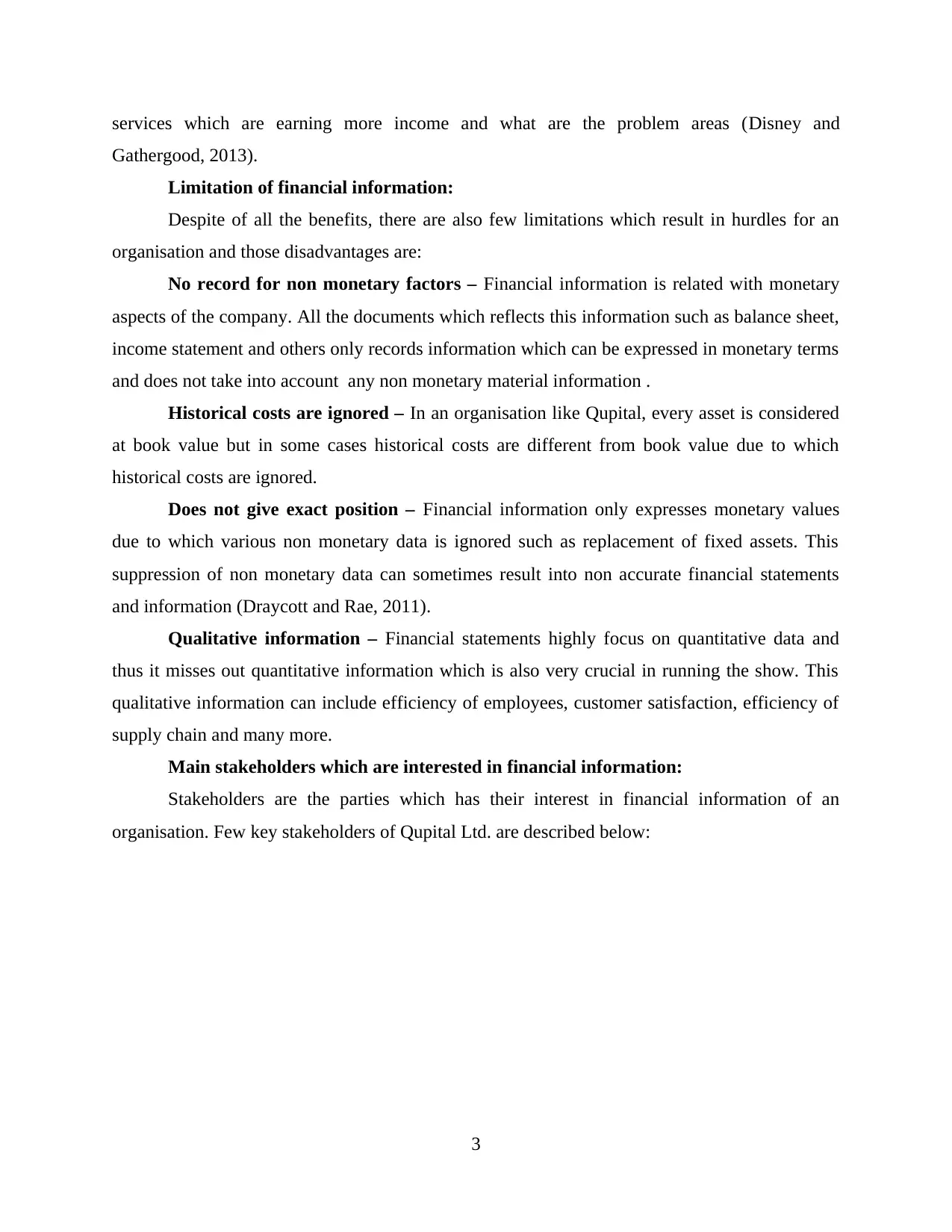
services which are earning more income and what are the problem areas (Disney and
Gathergood, 2013).
Limitation of financial information:
Despite of all the benefits, there are also few limitations which result in hurdles for an
organisation and those disadvantages are:
No record for non monetary factors – Financial information is related with monetary
aspects of the company. All the documents which reflects this information such as balance sheet,
income statement and others only records information which can be expressed in monetary terms
and does not take into account any non monetary material information .
Historical costs are ignored – In an organisation like Qupital, every asset is considered
at book value but in some cases historical costs are different from book value due to which
historical costs are ignored.
Does not give exact position – Financial information only expresses monetary values
due to which various non monetary data is ignored such as replacement of fixed assets. This
suppression of non monetary data can sometimes result into non accurate financial statements
and information (Draycott and Rae, 2011).
Qualitative information – Financial statements highly focus on quantitative data and
thus it misses out quantitative information which is also very crucial in running the show. This
qualitative information can include efficiency of employees, customer satisfaction, efficiency of
supply chain and many more.
Main stakeholders which are interested in financial information:
Stakeholders are the parties which has their interest in financial information of an
organisation. Few key stakeholders of Qupital Ltd. are described below:
3
Gathergood, 2013).
Limitation of financial information:
Despite of all the benefits, there are also few limitations which result in hurdles for an
organisation and those disadvantages are:
No record for non monetary factors – Financial information is related with monetary
aspects of the company. All the documents which reflects this information such as balance sheet,
income statement and others only records information which can be expressed in monetary terms
and does not take into account any non monetary material information .
Historical costs are ignored – In an organisation like Qupital, every asset is considered
at book value but in some cases historical costs are different from book value due to which
historical costs are ignored.
Does not give exact position – Financial information only expresses monetary values
due to which various non monetary data is ignored such as replacement of fixed assets. This
suppression of non monetary data can sometimes result into non accurate financial statements
and information (Draycott and Rae, 2011).
Qualitative information – Financial statements highly focus on quantitative data and
thus it misses out quantitative information which is also very crucial in running the show. This
qualitative information can include efficiency of employees, customer satisfaction, efficiency of
supply chain and many more.
Main stakeholders which are interested in financial information:
Stakeholders are the parties which has their interest in financial information of an
organisation. Few key stakeholders of Qupital Ltd. are described below:
3
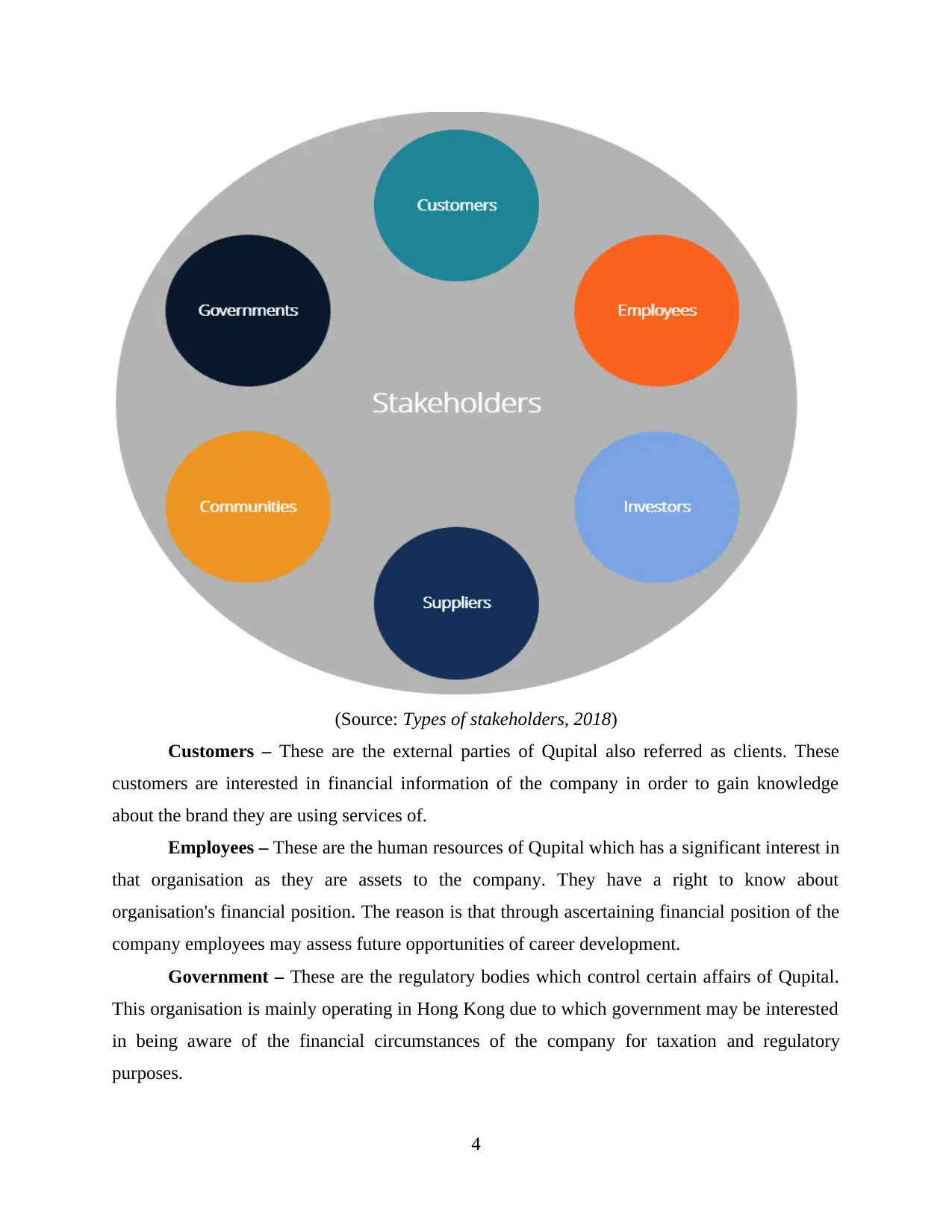
(Source: Types of stakeholders, 2018)
Customers – These are the external parties of Qupital also referred as clients. These
customers are interested in financial information of the company in order to gain knowledge
about the brand they are using services of.
Employees – These are the human resources of Qupital which has a significant interest in
that organisation as they are assets to the company. They have a right to know about
organisation's financial position. The reason is that through ascertaining financial position of the
company employees may assess future opportunities of career development.
Government – These are the regulatory bodies which control certain affairs of Qupital.
This organisation is mainly operating in Hong Kong due to which government may be interested
in being aware of the financial circumstances of the company for taxation and regulatory
purposes.
4
Customers – These are the external parties of Qupital also referred as clients. These
customers are interested in financial information of the company in order to gain knowledge
about the brand they are using services of.
Employees – These are the human resources of Qupital which has a significant interest in
that organisation as they are assets to the company. They have a right to know about
organisation's financial position. The reason is that through ascertaining financial position of the
company employees may assess future opportunities of career development.
Government – These are the regulatory bodies which control certain affairs of Qupital.
This organisation is mainly operating in Hong Kong due to which government may be interested
in being aware of the financial circumstances of the company for taxation and regulatory
purposes.
4
Paraphrase This Document
Need a fresh take? Get an instant paraphrase of this document with our AI Paraphraser
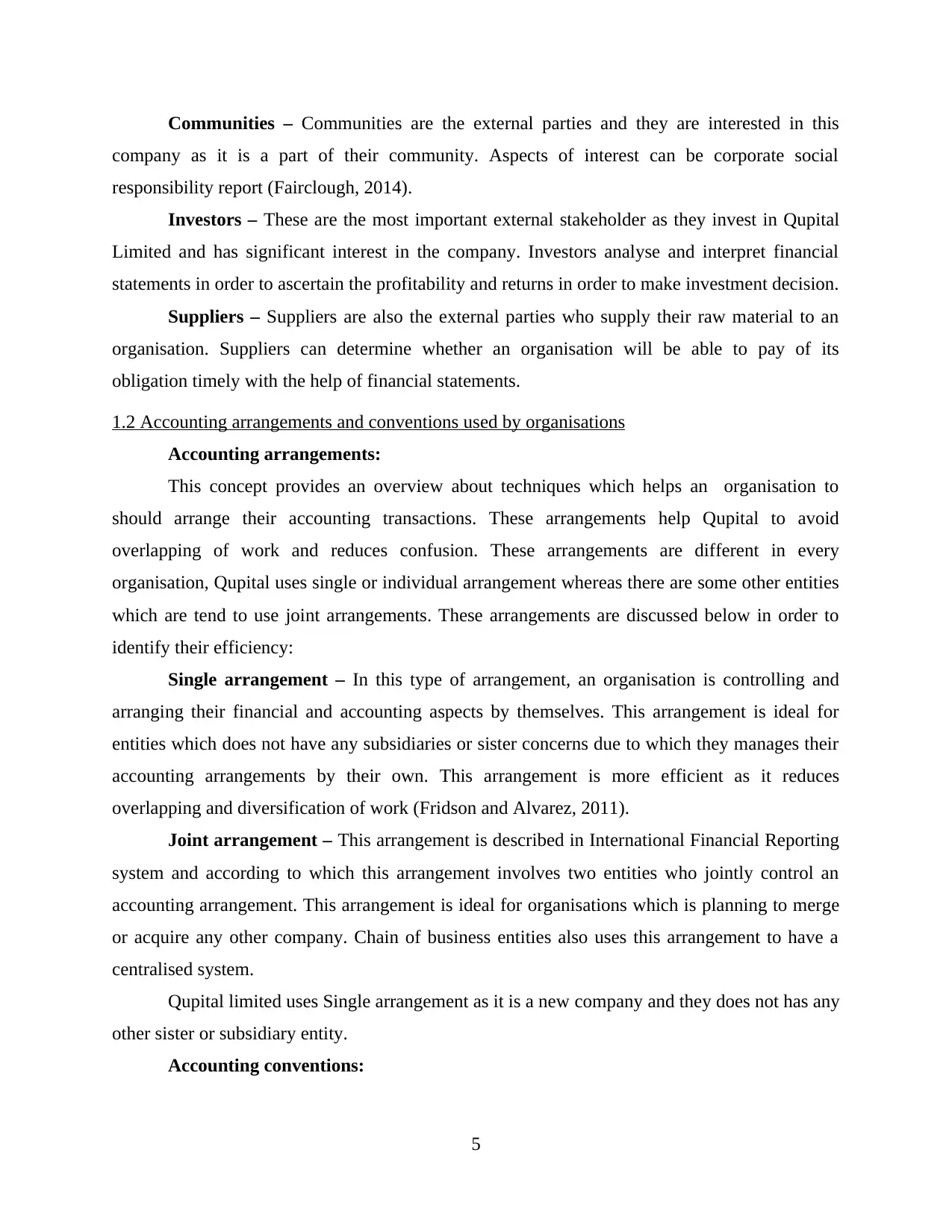
Communities – Communities are the external parties and they are interested in this
company as it is a part of their community. Aspects of interest can be corporate social
responsibility report (Fairclough, 2014).
Investors – These are the most important external stakeholder as they invest in Qupital
Limited and has significant interest in the company. Investors analyse and interpret financial
statements in order to ascertain the profitability and returns in order to make investment decision.
Suppliers – Suppliers are also the external parties who supply their raw material to an
organisation. Suppliers can determine whether an organisation will be able to pay of its
obligation timely with the help of financial statements.
1.2 Accounting arrangements and conventions used by organisations
Accounting arrangements:
This concept provides an overview about techniques which helps an organisation to
should arrange their accounting transactions. These arrangements help Qupital to avoid
overlapping of work and reduces confusion. These arrangements are different in every
organisation, Qupital uses single or individual arrangement whereas there are some other entities
which are tend to use joint arrangements. These arrangements are discussed below in order to
identify their efficiency:
Single arrangement – In this type of arrangement, an organisation is controlling and
arranging their financial and accounting aspects by themselves. This arrangement is ideal for
entities which does not have any subsidiaries or sister concerns due to which they manages their
accounting arrangements by their own. This arrangement is more efficient as it reduces
overlapping and diversification of work (Fridson and Alvarez, 2011).
Joint arrangement – This arrangement is described in International Financial Reporting
system and according to which this arrangement involves two entities who jointly control an
accounting arrangement. This arrangement is ideal for organisations which is planning to merge
or acquire any other company. Chain of business entities also uses this arrangement to have a
centralised system.
Qupital limited uses Single arrangement as it is a new company and they does not has any
other sister or subsidiary entity.
Accounting conventions:
5
company as it is a part of their community. Aspects of interest can be corporate social
responsibility report (Fairclough, 2014).
Investors – These are the most important external stakeholder as they invest in Qupital
Limited and has significant interest in the company. Investors analyse and interpret financial
statements in order to ascertain the profitability and returns in order to make investment decision.
Suppliers – Suppliers are also the external parties who supply their raw material to an
organisation. Suppliers can determine whether an organisation will be able to pay of its
obligation timely with the help of financial statements.
1.2 Accounting arrangements and conventions used by organisations
Accounting arrangements:
This concept provides an overview about techniques which helps an organisation to
should arrange their accounting transactions. These arrangements help Qupital to avoid
overlapping of work and reduces confusion. These arrangements are different in every
organisation, Qupital uses single or individual arrangement whereas there are some other entities
which are tend to use joint arrangements. These arrangements are discussed below in order to
identify their efficiency:
Single arrangement – In this type of arrangement, an organisation is controlling and
arranging their financial and accounting aspects by themselves. This arrangement is ideal for
entities which does not have any subsidiaries or sister concerns due to which they manages their
accounting arrangements by their own. This arrangement is more efficient as it reduces
overlapping and diversification of work (Fridson and Alvarez, 2011).
Joint arrangement – This arrangement is described in International Financial Reporting
system and according to which this arrangement involves two entities who jointly control an
accounting arrangement. This arrangement is ideal for organisations which is planning to merge
or acquire any other company. Chain of business entities also uses this arrangement to have a
centralised system.
Qupital limited uses Single arrangement as it is a new company and they does not has any
other sister or subsidiary entity.
Accounting conventions:
5
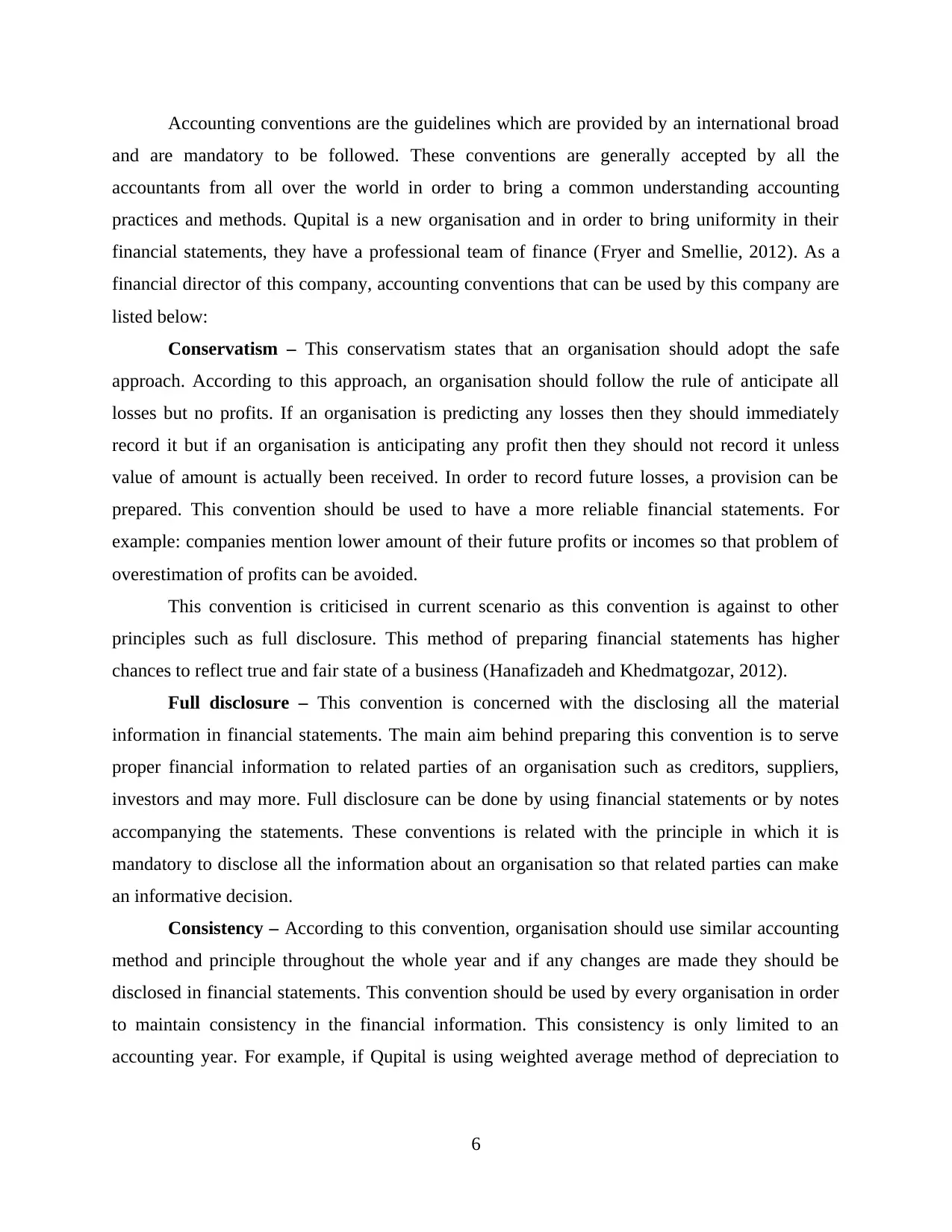
Accounting conventions are the guidelines which are provided by an international broad
and are mandatory to be followed. These conventions are generally accepted by all the
accountants from all over the world in order to bring a common understanding accounting
practices and methods. Qupital is a new organisation and in order to bring uniformity in their
financial statements, they have a professional team of finance (Fryer and Smellie, 2012). As a
financial director of this company, accounting conventions that can be used by this company are
listed below:
Conservatism – This conservatism states that an organisation should adopt the safe
approach. According to this approach, an organisation should follow the rule of anticipate all
losses but no profits. If an organisation is predicting any losses then they should immediately
record it but if an organisation is anticipating any profit then they should not record it unless
value of amount is actually been received. In order to record future losses, a provision can be
prepared. This convention should be used to have a more reliable financial statements. For
example: companies mention lower amount of their future profits or incomes so that problem of
overestimation of profits can be avoided.
This convention is criticised in current scenario as this convention is against to other
principles such as full disclosure. This method of preparing financial statements has higher
chances to reflect true and fair state of a business (Hanafizadeh and Khedmatgozar, 2012).
Full disclosure – This convention is concerned with the disclosing all the material
information in financial statements. The main aim behind preparing this convention is to serve
proper financial information to related parties of an organisation such as creditors, suppliers,
investors and may more. Full disclosure can be done by using financial statements or by notes
accompanying the statements. These conventions is related with the principle in which it is
mandatory to disclose all the information about an organisation so that related parties can make
an informative decision.
Consistency – According to this convention, organisation should use similar accounting
method and principle throughout the whole year and if any changes are made they should be
disclosed in financial statements. This convention should be used by every organisation in order
to maintain consistency in the financial information. This consistency is only limited to an
accounting year. For example, if Qupital is using weighted average method of depreciation to
6
and are mandatory to be followed. These conventions are generally accepted by all the
accountants from all over the world in order to bring a common understanding accounting
practices and methods. Qupital is a new organisation and in order to bring uniformity in their
financial statements, they have a professional team of finance (Fryer and Smellie, 2012). As a
financial director of this company, accounting conventions that can be used by this company are
listed below:
Conservatism – This conservatism states that an organisation should adopt the safe
approach. According to this approach, an organisation should follow the rule of anticipate all
losses but no profits. If an organisation is predicting any losses then they should immediately
record it but if an organisation is anticipating any profit then they should not record it unless
value of amount is actually been received. In order to record future losses, a provision can be
prepared. This convention should be used to have a more reliable financial statements. For
example: companies mention lower amount of their future profits or incomes so that problem of
overestimation of profits can be avoided.
This convention is criticised in current scenario as this convention is against to other
principles such as full disclosure. This method of preparing financial statements has higher
chances to reflect true and fair state of a business (Hanafizadeh and Khedmatgozar, 2012).
Full disclosure – This convention is concerned with the disclosing all the material
information in financial statements. The main aim behind preparing this convention is to serve
proper financial information to related parties of an organisation such as creditors, suppliers,
investors and may more. Full disclosure can be done by using financial statements or by notes
accompanying the statements. These conventions is related with the principle in which it is
mandatory to disclose all the information about an organisation so that related parties can make
an informative decision.
Consistency – According to this convention, organisation should use similar accounting
method and principle throughout the whole year and if any changes are made they should be
disclosed in financial statements. This convention should be used by every organisation in order
to maintain consistency in the financial information. This consistency is only limited to an
accounting year. For example, if Qupital is using weighted average method of depreciation to
6
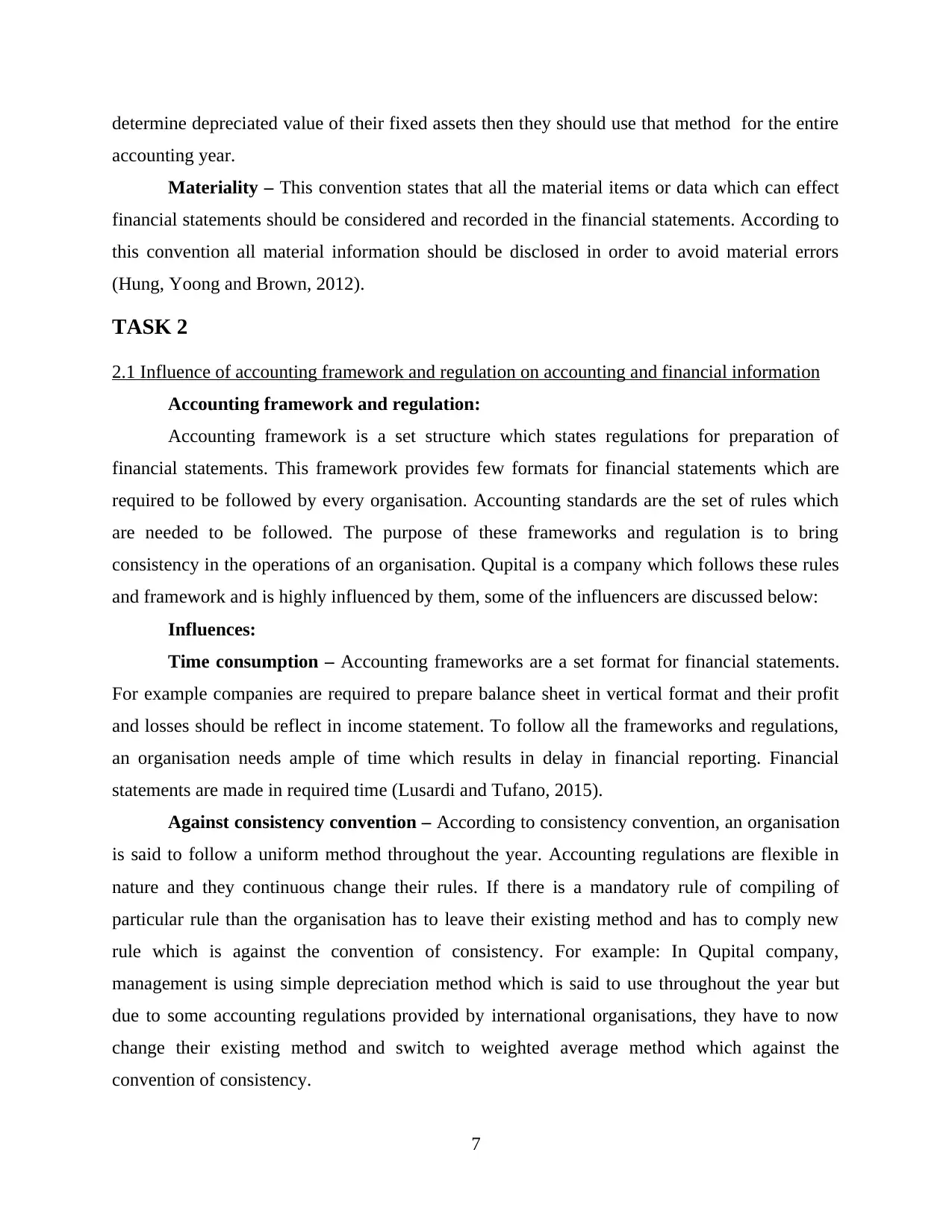
determine depreciated value of their fixed assets then they should use that method for the entire
accounting year.
Materiality – This convention states that all the material items or data which can effect
financial statements should be considered and recorded in the financial statements. According to
this convention all material information should be disclosed in order to avoid material errors
(Hung, Yoong and Brown, 2012).
TASK 2
2.1 Influence of accounting framework and regulation on accounting and financial information
Accounting framework and regulation:
Accounting framework is a set structure which states regulations for preparation of
financial statements. This framework provides few formats for financial statements which are
required to be followed by every organisation. Accounting standards are the set of rules which
are needed to be followed. The purpose of these frameworks and regulation is to bring
consistency in the operations of an organisation. Qupital is a company which follows these rules
and framework and is highly influenced by them, some of the influencers are discussed below:
Influences:
Time consumption – Accounting frameworks are a set format for financial statements.
For example companies are required to prepare balance sheet in vertical format and their profit
and losses should be reflect in income statement. To follow all the frameworks and regulations,
an organisation needs ample of time which results in delay in financial reporting. Financial
statements are made in required time (Lusardi and Tufano, 2015).
Against consistency convention – According to consistency convention, an organisation
is said to follow a uniform method throughout the year. Accounting regulations are flexible in
nature and they continuous change their rules. If there is a mandatory rule of compiling of
particular rule than the organisation has to leave their existing method and has to comply new
rule which is against the convention of consistency. For example: In Qupital company,
management is using simple depreciation method which is said to use throughout the year but
due to some accounting regulations provided by international organisations, they have to now
change their existing method and switch to weighted average method which against the
convention of consistency.
7
accounting year.
Materiality – This convention states that all the material items or data which can effect
financial statements should be considered and recorded in the financial statements. According to
this convention all material information should be disclosed in order to avoid material errors
(Hung, Yoong and Brown, 2012).
TASK 2
2.1 Influence of accounting framework and regulation on accounting and financial information
Accounting framework and regulation:
Accounting framework is a set structure which states regulations for preparation of
financial statements. This framework provides few formats for financial statements which are
required to be followed by every organisation. Accounting standards are the set of rules which
are needed to be followed. The purpose of these frameworks and regulation is to bring
consistency in the operations of an organisation. Qupital is a company which follows these rules
and framework and is highly influenced by them, some of the influencers are discussed below:
Influences:
Time consumption – Accounting frameworks are a set format for financial statements.
For example companies are required to prepare balance sheet in vertical format and their profit
and losses should be reflect in income statement. To follow all the frameworks and regulations,
an organisation needs ample of time which results in delay in financial reporting. Financial
statements are made in required time (Lusardi and Tufano, 2015).
Against consistency convention – According to consistency convention, an organisation
is said to follow a uniform method throughout the year. Accounting regulations are flexible in
nature and they continuous change their rules. If there is a mandatory rule of compiling of
particular rule than the organisation has to leave their existing method and has to comply new
rule which is against the convention of consistency. For example: In Qupital company,
management is using simple depreciation method which is said to use throughout the year but
due to some accounting regulations provided by international organisations, they have to now
change their existing method and switch to weighted average method which against the
convention of consistency.
7
Secure Best Marks with AI Grader
Need help grading? Try our AI Grader for instant feedback on your assignments.
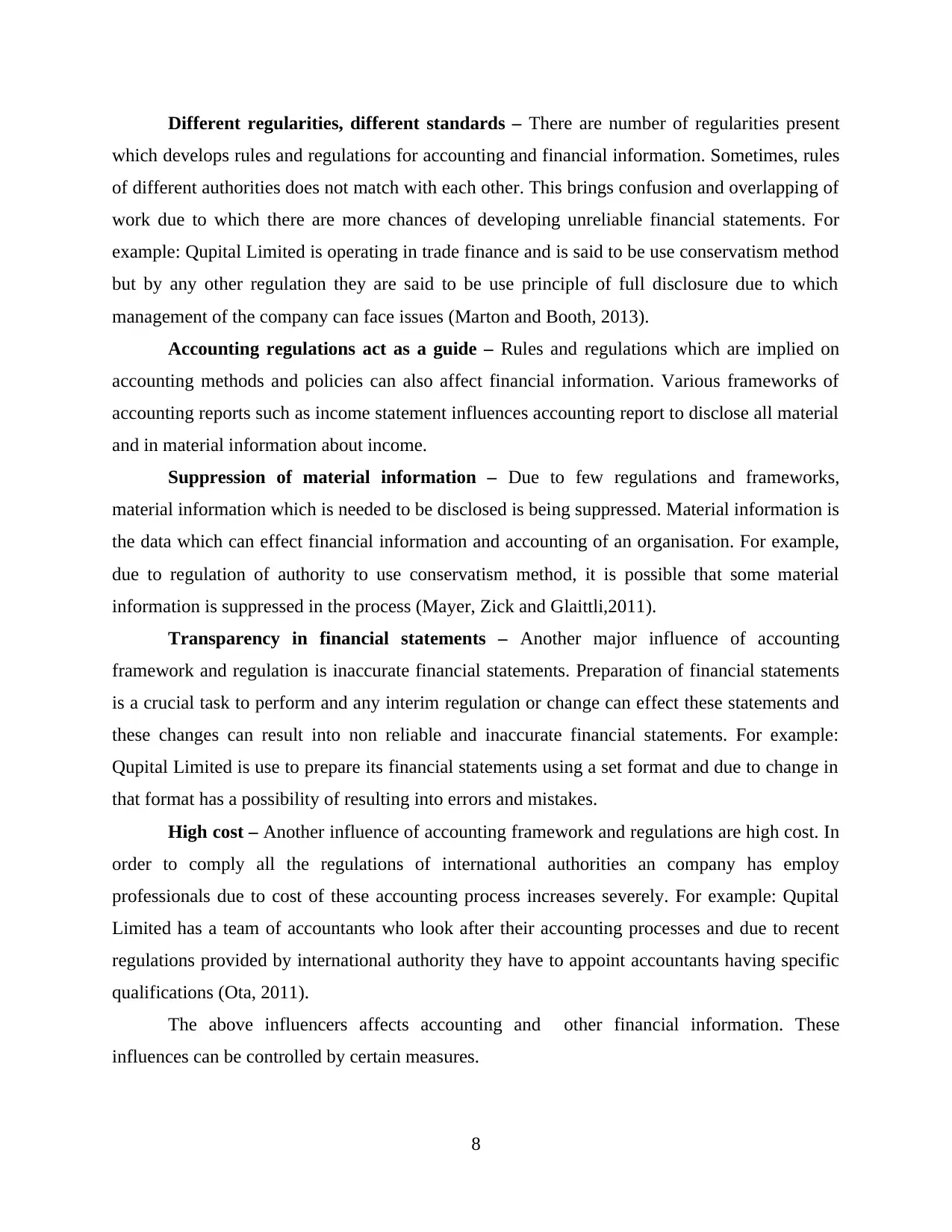
Different regularities, different standards – There are number of regularities present
which develops rules and regulations for accounting and financial information. Sometimes, rules
of different authorities does not match with each other. This brings confusion and overlapping of
work due to which there are more chances of developing unreliable financial statements. For
example: Qupital Limited is operating in trade finance and is said to be use conservatism method
but by any other regulation they are said to be use principle of full disclosure due to which
management of the company can face issues (Marton and Booth, 2013).
Accounting regulations act as a guide – Rules and regulations which are implied on
accounting methods and policies can also affect financial information. Various frameworks of
accounting reports such as income statement influences accounting report to disclose all material
and in material information about income.
Suppression of material information – Due to few regulations and frameworks,
material information which is needed to be disclosed is being suppressed. Material information is
the data which can effect financial information and accounting of an organisation. For example,
due to regulation of authority to use conservatism method, it is possible that some material
information is suppressed in the process (Mayer, Zick and Glaittli,2011).
Transparency in financial statements – Another major influence of accounting
framework and regulation is inaccurate financial statements. Preparation of financial statements
is a crucial task to perform and any interim regulation or change can effect these statements and
these changes can result into non reliable and inaccurate financial statements. For example:
Qupital Limited is use to prepare its financial statements using a set format and due to change in
that format has a possibility of resulting into errors and mistakes.
High cost – Another influence of accounting framework and regulations are high cost. In
order to comply all the regulations of international authorities an company has employ
professionals due to cost of these accounting process increases severely. For example: Qupital
Limited has a team of accountants who look after their accounting processes and due to recent
regulations provided by international authority they have to appoint accountants having specific
qualifications (Ota, 2011).
The above influencers affects accounting and other financial information. These
influences can be controlled by certain measures.
8
which develops rules and regulations for accounting and financial information. Sometimes, rules
of different authorities does not match with each other. This brings confusion and overlapping of
work due to which there are more chances of developing unreliable financial statements. For
example: Qupital Limited is operating in trade finance and is said to be use conservatism method
but by any other regulation they are said to be use principle of full disclosure due to which
management of the company can face issues (Marton and Booth, 2013).
Accounting regulations act as a guide – Rules and regulations which are implied on
accounting methods and policies can also affect financial information. Various frameworks of
accounting reports such as income statement influences accounting report to disclose all material
and in material information about income.
Suppression of material information – Due to few regulations and frameworks,
material information which is needed to be disclosed is being suppressed. Material information is
the data which can effect financial information and accounting of an organisation. For example,
due to regulation of authority to use conservatism method, it is possible that some material
information is suppressed in the process (Mayer, Zick and Glaittli,2011).
Transparency in financial statements – Another major influence of accounting
framework and regulation is inaccurate financial statements. Preparation of financial statements
is a crucial task to perform and any interim regulation or change can effect these statements and
these changes can result into non reliable and inaccurate financial statements. For example:
Qupital Limited is use to prepare its financial statements using a set format and due to change in
that format has a possibility of resulting into errors and mistakes.
High cost – Another influence of accounting framework and regulations are high cost. In
order to comply all the regulations of international authorities an company has employ
professionals due to cost of these accounting process increases severely. For example: Qupital
Limited has a team of accountants who look after their accounting processes and due to recent
regulations provided by international authority they have to appoint accountants having specific
qualifications (Ota, 2011).
The above influencers affects accounting and other financial information. These
influences can be controlled by certain measures.
8
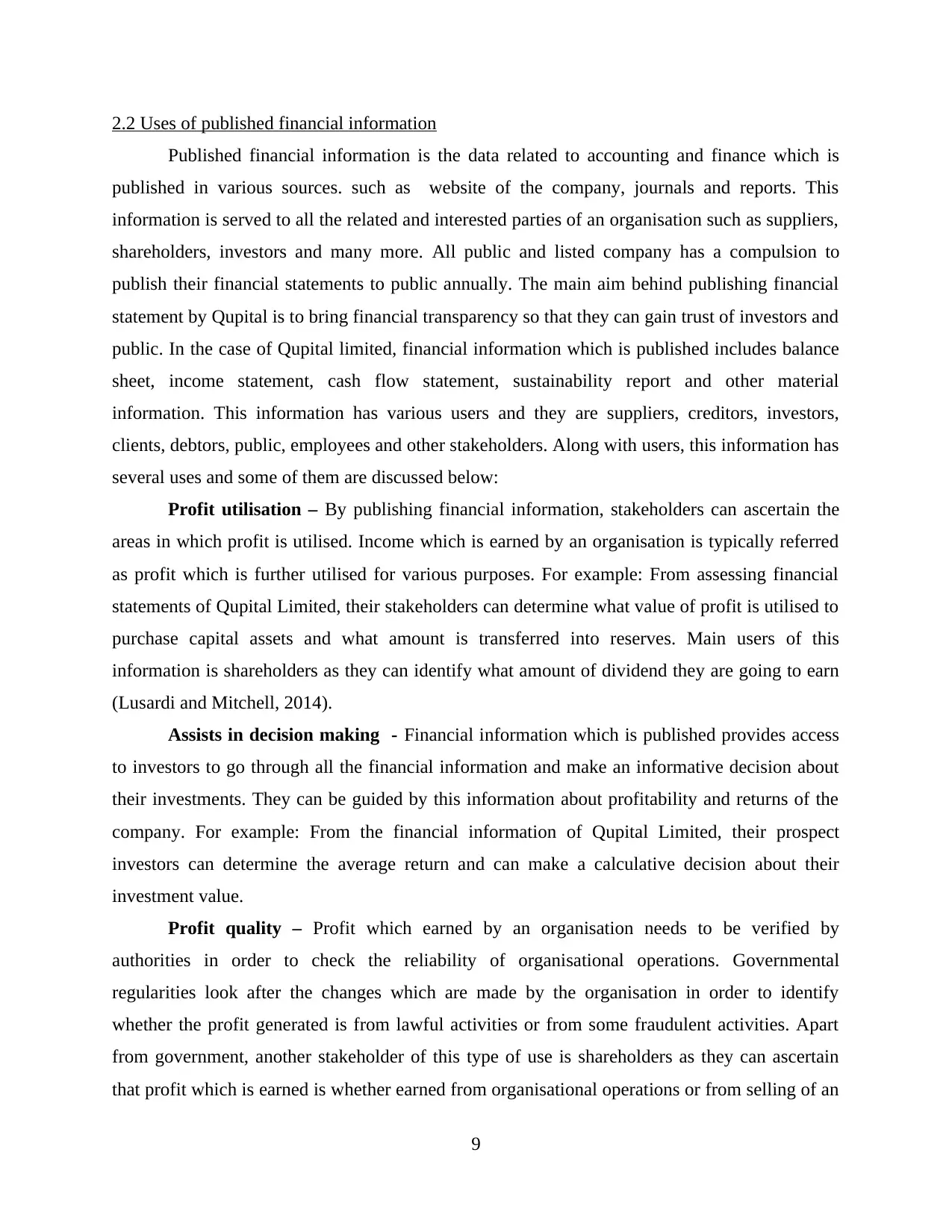
2.2 Uses of published financial information
Published financial information is the data related to accounting and finance which is
published in various sources. such as website of the company, journals and reports. This
information is served to all the related and interested parties of an organisation such as suppliers,
shareholders, investors and many more. All public and listed company has a compulsion to
publish their financial statements to public annually. The main aim behind publishing financial
statement by Qupital is to bring financial transparency so that they can gain trust of investors and
public. In the case of Qupital limited, financial information which is published includes balance
sheet, income statement, cash flow statement, sustainability report and other material
information. This information has various users and they are suppliers, creditors, investors,
clients, debtors, public, employees and other stakeholders. Along with users, this information has
several uses and some of them are discussed below:
Profit utilisation – By publishing financial information, stakeholders can ascertain the
areas in which profit is utilised. Income which is earned by an organisation is typically referred
as profit which is further utilised for various purposes. For example: From assessing financial
statements of Qupital Limited, their stakeholders can determine what value of profit is utilised to
purchase capital assets and what amount is transferred into reserves. Main users of this
information is shareholders as they can identify what amount of dividend they are going to earn
(Lusardi and Mitchell, 2014).
Assists in decision making - Financial information which is published provides access
to investors to go through all the financial information and make an informative decision about
their investments. They can be guided by this information about profitability and returns of the
company. For example: From the financial information of Qupital Limited, their prospect
investors can determine the average return and can make a calculative decision about their
investment value.
Profit quality – Profit which earned by an organisation needs to be verified by
authorities in order to check the reliability of organisational operations. Governmental
regularities look after the changes which are made by the organisation in order to identify
whether the profit generated is from lawful activities or from some fraudulent activities. Apart
from government, another stakeholder of this type of use is shareholders as they can ascertain
that profit which is earned is whether earned from organisational operations or from selling of an
9
Published financial information is the data related to accounting and finance which is
published in various sources. such as website of the company, journals and reports. This
information is served to all the related and interested parties of an organisation such as suppliers,
shareholders, investors and many more. All public and listed company has a compulsion to
publish their financial statements to public annually. The main aim behind publishing financial
statement by Qupital is to bring financial transparency so that they can gain trust of investors and
public. In the case of Qupital limited, financial information which is published includes balance
sheet, income statement, cash flow statement, sustainability report and other material
information. This information has various users and they are suppliers, creditors, investors,
clients, debtors, public, employees and other stakeholders. Along with users, this information has
several uses and some of them are discussed below:
Profit utilisation – By publishing financial information, stakeholders can ascertain the
areas in which profit is utilised. Income which is earned by an organisation is typically referred
as profit which is further utilised for various purposes. For example: From assessing financial
statements of Qupital Limited, their stakeholders can determine what value of profit is utilised to
purchase capital assets and what amount is transferred into reserves. Main users of this
information is shareholders as they can identify what amount of dividend they are going to earn
(Lusardi and Mitchell, 2014).
Assists in decision making - Financial information which is published provides access
to investors to go through all the financial information and make an informative decision about
their investments. They can be guided by this information about profitability and returns of the
company. For example: From the financial information of Qupital Limited, their prospect
investors can determine the average return and can make a calculative decision about their
investment value.
Profit quality – Profit which earned by an organisation needs to be verified by
authorities in order to check the reliability of organisational operations. Governmental
regularities look after the changes which are made by the organisation in order to identify
whether the profit generated is from lawful activities or from some fraudulent activities. Apart
from government, another stakeholder of this type of use is shareholders as they can ascertain
that profit which is earned is whether earned from organisational operations or from selling of an
9
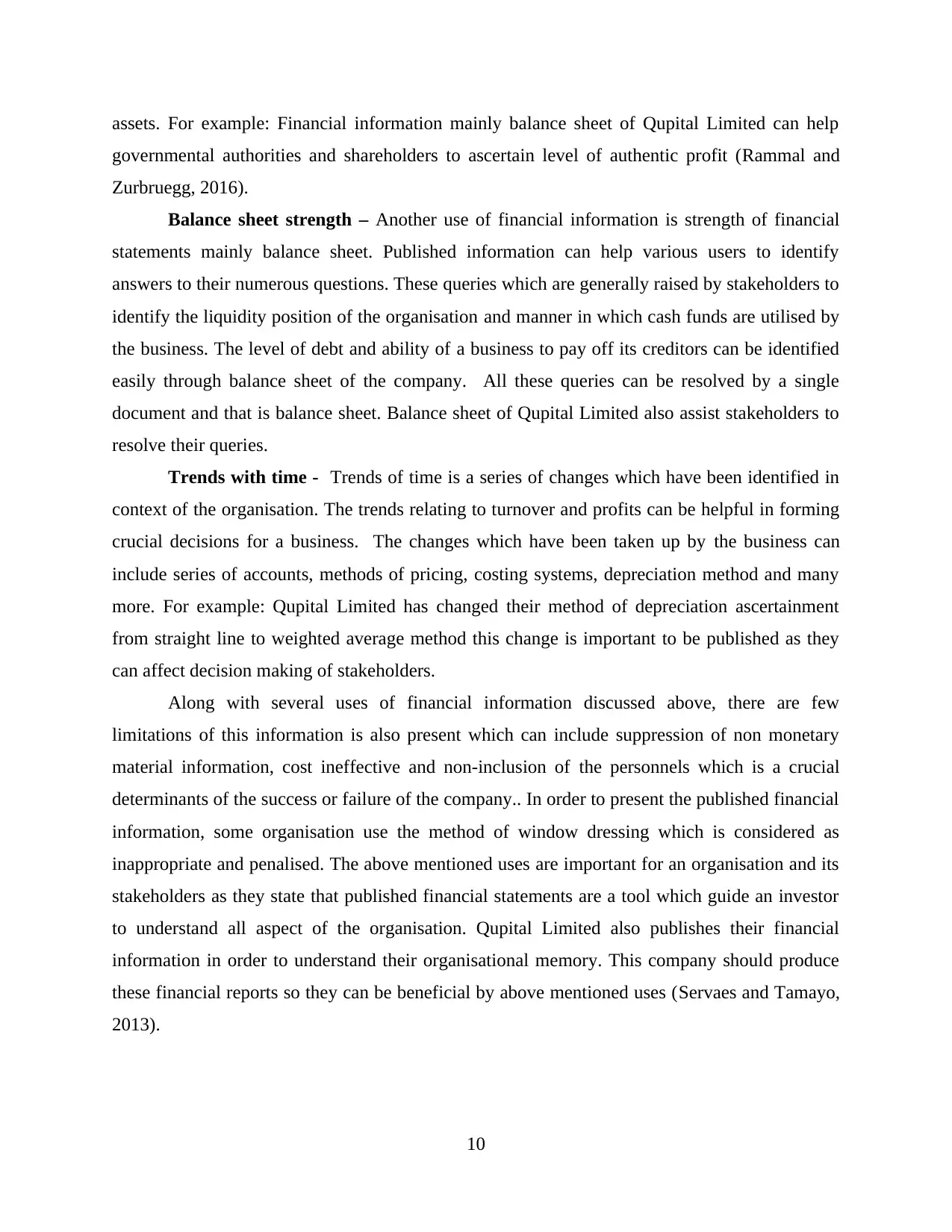
assets. For example: Financial information mainly balance sheet of Qupital Limited can help
governmental authorities and shareholders to ascertain level of authentic profit (Rammal and
Zurbruegg, 2016).
Balance sheet strength – Another use of financial information is strength of financial
statements mainly balance sheet. Published information can help various users to identify
answers to their numerous questions. These queries which are generally raised by stakeholders to
identify the liquidity position of the organisation and manner in which cash funds are utilised by
the business. The level of debt and ability of a business to pay off its creditors can be identified
easily through balance sheet of the company. All these queries can be resolved by a single
document and that is balance sheet. Balance sheet of Qupital Limited also assist stakeholders to
resolve their queries.
Trends with time - Trends of time is a series of changes which have been identified in
context of the organisation. The trends relating to turnover and profits can be helpful in forming
crucial decisions for a business. The changes which have been taken up by the business can
include series of accounts, methods of pricing, costing systems, depreciation method and many
more. For example: Qupital Limited has changed their method of depreciation ascertainment
from straight line to weighted average method this change is important to be published as they
can affect decision making of stakeholders.
Along with several uses of financial information discussed above, there are few
limitations of this information is also present which can include suppression of non monetary
material information, cost ineffective and non-inclusion of the personnels which is a crucial
determinants of the success or failure of the company.. In order to present the published financial
information, some organisation use the method of window dressing which is considered as
inappropriate and penalised. The above mentioned uses are important for an organisation and its
stakeholders as they state that published financial statements are a tool which guide an investor
to understand all aspect of the organisation. Qupital Limited also publishes their financial
information in order to understand their organisational memory. This company should produce
these financial reports so they can be beneficial by above mentioned uses (Servaes and Tamayo,
2013).
10
governmental authorities and shareholders to ascertain level of authentic profit (Rammal and
Zurbruegg, 2016).
Balance sheet strength – Another use of financial information is strength of financial
statements mainly balance sheet. Published information can help various users to identify
answers to their numerous questions. These queries which are generally raised by stakeholders to
identify the liquidity position of the organisation and manner in which cash funds are utilised by
the business. The level of debt and ability of a business to pay off its creditors can be identified
easily through balance sheet of the company. All these queries can be resolved by a single
document and that is balance sheet. Balance sheet of Qupital Limited also assist stakeholders to
resolve their queries.
Trends with time - Trends of time is a series of changes which have been identified in
context of the organisation. The trends relating to turnover and profits can be helpful in forming
crucial decisions for a business. The changes which have been taken up by the business can
include series of accounts, methods of pricing, costing systems, depreciation method and many
more. For example: Qupital Limited has changed their method of depreciation ascertainment
from straight line to weighted average method this change is important to be published as they
can affect decision making of stakeholders.
Along with several uses of financial information discussed above, there are few
limitations of this information is also present which can include suppression of non monetary
material information, cost ineffective and non-inclusion of the personnels which is a crucial
determinants of the success or failure of the company.. In order to present the published financial
information, some organisation use the method of window dressing which is considered as
inappropriate and penalised. The above mentioned uses are important for an organisation and its
stakeholders as they state that published financial statements are a tool which guide an investor
to understand all aspect of the organisation. Qupital Limited also publishes their financial
information in order to understand their organisational memory. This company should produce
these financial reports so they can be beneficial by above mentioned uses (Servaes and Tamayo,
2013).
10
Paraphrase This Document
Need a fresh take? Get an instant paraphrase of this document with our AI Paraphraser
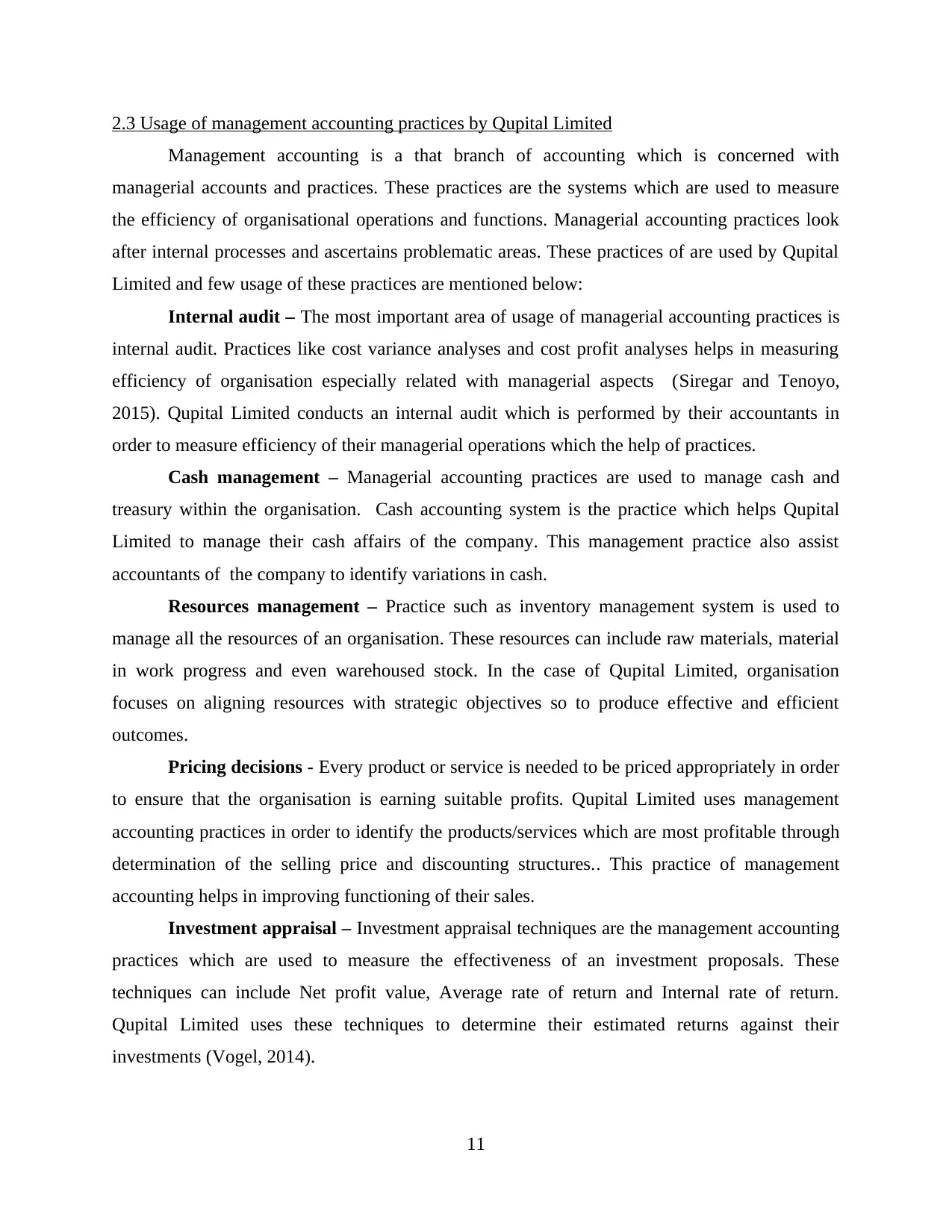
2.3 Usage of management accounting practices by Qupital Limited
Management accounting is a that branch of accounting which is concerned with
managerial accounts and practices. These practices are the systems which are used to measure
the efficiency of organisational operations and functions. Managerial accounting practices look
after internal processes and ascertains problematic areas. These practices of are used by Qupital
Limited and few usage of these practices are mentioned below:
Internal audit – The most important area of usage of managerial accounting practices is
internal audit. Practices like cost variance analyses and cost profit analyses helps in measuring
efficiency of organisation especially related with managerial aspects (Siregar and Tenoyo,
2015). Qupital Limited conducts an internal audit which is performed by their accountants in
order to measure efficiency of their managerial operations which the help of practices.
Cash management – Managerial accounting practices are used to manage cash and
treasury within the organisation. Cash accounting system is the practice which helps Qupital
Limited to manage their cash affairs of the company. This management practice also assist
accountants of the company to identify variations in cash.
Resources management – Practice such as inventory management system is used to
manage all the resources of an organisation. These resources can include raw materials, material
in work progress and even warehoused stock. In the case of Qupital Limited, organisation
focuses on aligning resources with strategic objectives so to produce effective and efficient
outcomes.
Pricing decisions - Every product or service is needed to be priced appropriately in order
to ensure that the organisation is earning suitable profits. Qupital Limited uses management
accounting practices in order to identify the products/services which are most profitable through
determination of the selling price and discounting structures.. This practice of management
accounting helps in improving functioning of their sales.
Investment appraisal – Investment appraisal techniques are the management accounting
practices which are used to measure the effectiveness of an investment proposals. These
techniques can include Net profit value, Average rate of return and Internal rate of return.
Qupital Limited uses these techniques to determine their estimated returns against their
investments (Vogel, 2014).
11
Management accounting is a that branch of accounting which is concerned with
managerial accounts and practices. These practices are the systems which are used to measure
the efficiency of organisational operations and functions. Managerial accounting practices look
after internal processes and ascertains problematic areas. These practices of are used by Qupital
Limited and few usage of these practices are mentioned below:
Internal audit – The most important area of usage of managerial accounting practices is
internal audit. Practices like cost variance analyses and cost profit analyses helps in measuring
efficiency of organisation especially related with managerial aspects (Siregar and Tenoyo,
2015). Qupital Limited conducts an internal audit which is performed by their accountants in
order to measure efficiency of their managerial operations which the help of practices.
Cash management – Managerial accounting practices are used to manage cash and
treasury within the organisation. Cash accounting system is the practice which helps Qupital
Limited to manage their cash affairs of the company. This management practice also assist
accountants of the company to identify variations in cash.
Resources management – Practice such as inventory management system is used to
manage all the resources of an organisation. These resources can include raw materials, material
in work progress and even warehoused stock. In the case of Qupital Limited, organisation
focuses on aligning resources with strategic objectives so to produce effective and efficient
outcomes.
Pricing decisions - Every product or service is needed to be priced appropriately in order
to ensure that the organisation is earning suitable profits. Qupital Limited uses management
accounting practices in order to identify the products/services which are most profitable through
determination of the selling price and discounting structures.. This practice of management
accounting helps in improving functioning of their sales.
Investment appraisal – Investment appraisal techniques are the management accounting
practices which are used to measure the effectiveness of an investment proposals. These
techniques can include Net profit value, Average rate of return and Internal rate of return.
Qupital Limited uses these techniques to determine their estimated returns against their
investments (Vogel, 2014).
11
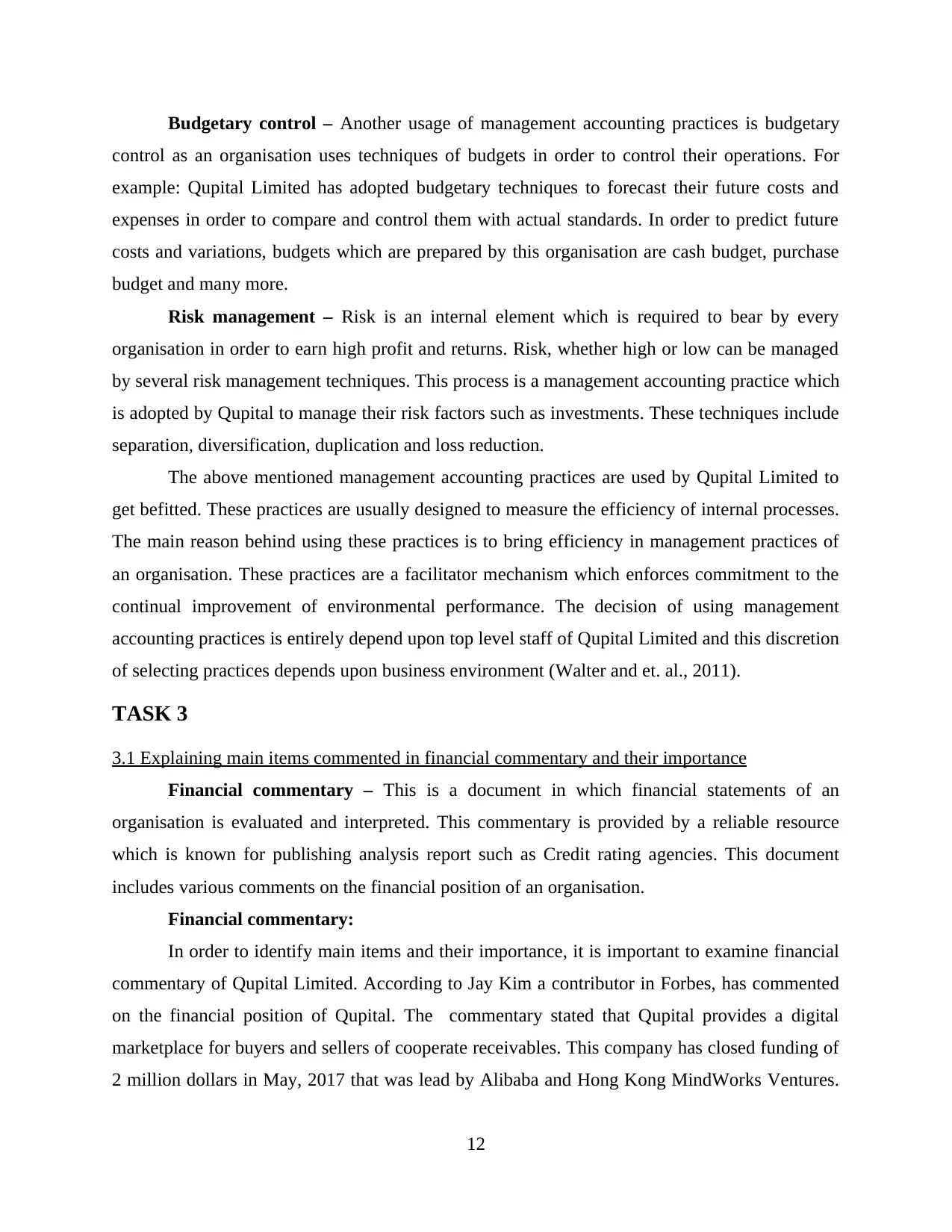
Budgetary control – Another usage of management accounting practices is budgetary
control as an organisation uses techniques of budgets in order to control their operations. For
example: Qupital Limited has adopted budgetary techniques to forecast their future costs and
expenses in order to compare and control them with actual standards. In order to predict future
costs and variations, budgets which are prepared by this organisation are cash budget, purchase
budget and many more.
Risk management – Risk is an internal element which is required to bear by every
organisation in order to earn high profit and returns. Risk, whether high or low can be managed
by several risk management techniques. This process is a management accounting practice which
is adopted by Qupital to manage their risk factors such as investments. These techniques include
separation, diversification, duplication and loss reduction.
The above mentioned management accounting practices are used by Qupital Limited to
get befitted. These practices are usually designed to measure the efficiency of internal processes.
The main reason behind using these practices is to bring efficiency in management practices of
an organisation. These practices are a facilitator mechanism which enforces commitment to the
continual improvement of environmental performance. The decision of using management
accounting practices is entirely depend upon top level staff of Qupital Limited and this discretion
of selecting practices depends upon business environment (Walter and et. al., 2011).
TASK 3
3.1 Explaining main items commented in financial commentary and their importance
Financial commentary – This is a document in which financial statements of an
organisation is evaluated and interpreted. This commentary is provided by a reliable resource
which is known for publishing analysis report such as Credit rating agencies. This document
includes various comments on the financial position of an organisation.
Financial commentary:
In order to identify main items and their importance, it is important to examine financial
commentary of Qupital Limited. According to Jay Kim a contributor in Forbes, has commented
on the financial position of Qupital. The commentary stated that Qupital provides a digital
marketplace for buyers and sellers of cooperate receivables. This company has closed funding of
2 million dollars in May, 2017 that was lead by Alibaba and Hong Kong MindWorks Ventures.
12
control as an organisation uses techniques of budgets in order to control their operations. For
example: Qupital Limited has adopted budgetary techniques to forecast their future costs and
expenses in order to compare and control them with actual standards. In order to predict future
costs and variations, budgets which are prepared by this organisation are cash budget, purchase
budget and many more.
Risk management – Risk is an internal element which is required to bear by every
organisation in order to earn high profit and returns. Risk, whether high or low can be managed
by several risk management techniques. This process is a management accounting practice which
is adopted by Qupital to manage their risk factors such as investments. These techniques include
separation, diversification, duplication and loss reduction.
The above mentioned management accounting practices are used by Qupital Limited to
get befitted. These practices are usually designed to measure the efficiency of internal processes.
The main reason behind using these practices is to bring efficiency in management practices of
an organisation. These practices are a facilitator mechanism which enforces commitment to the
continual improvement of environmental performance. The decision of using management
accounting practices is entirely depend upon top level staff of Qupital Limited and this discretion
of selecting practices depends upon business environment (Walter and et. al., 2011).
TASK 3
3.1 Explaining main items commented in financial commentary and their importance
Financial commentary – This is a document in which financial statements of an
organisation is evaluated and interpreted. This commentary is provided by a reliable resource
which is known for publishing analysis report such as Credit rating agencies. This document
includes various comments on the financial position of an organisation.
Financial commentary:
In order to identify main items and their importance, it is important to examine financial
commentary of Qupital Limited. According to Jay Kim a contributor in Forbes, has commented
on the financial position of Qupital. The commentary stated that Qupital provides a digital
marketplace for buyers and sellers of cooperate receivables. This company has closed funding of
2 million dollars in May, 2017 that was lead by Alibaba and Hong Kong MindWorks Ventures.
12
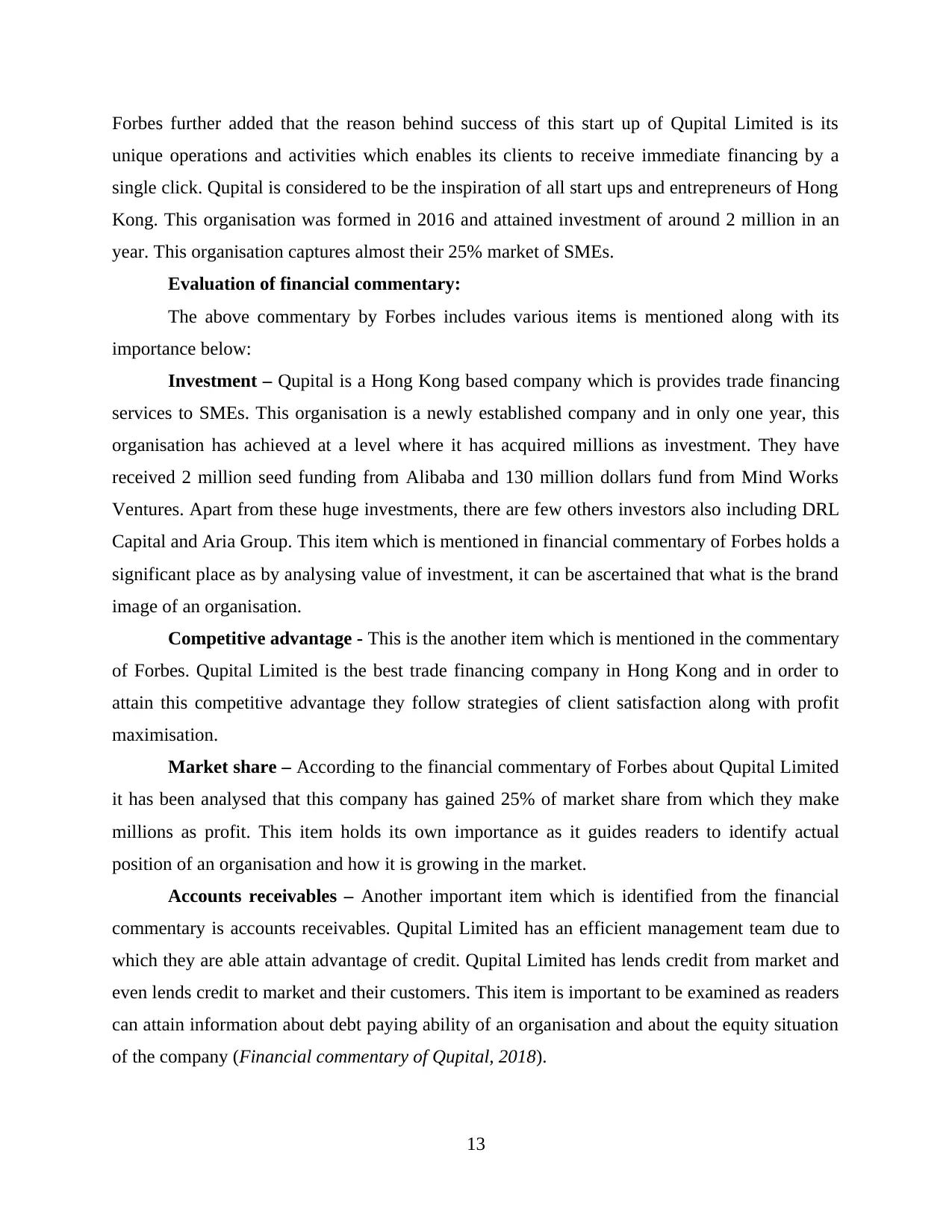
Forbes further added that the reason behind success of this start up of Qupital Limited is its
unique operations and activities which enables its clients to receive immediate financing by a
single click. Qupital is considered to be the inspiration of all start ups and entrepreneurs of Hong
Kong. This organisation was formed in 2016 and attained investment of around 2 million in an
year. This organisation captures almost their 25% market of SMEs.
Evaluation of financial commentary:
The above commentary by Forbes includes various items is mentioned along with its
importance below:
Investment – Qupital is a Hong Kong based company which is provides trade financing
services to SMEs. This organisation is a newly established company and in only one year, this
organisation has achieved at a level where it has acquired millions as investment. They have
received 2 million seed funding from Alibaba and 130 million dollars fund from Mind Works
Ventures. Apart from these huge investments, there are few others investors also including DRL
Capital and Aria Group. This item which is mentioned in financial commentary of Forbes holds a
significant place as by analysing value of investment, it can be ascertained that what is the brand
image of an organisation.
Competitive advantage - This is the another item which is mentioned in the commentary
of Forbes. Qupital Limited is the best trade financing company in Hong Kong and in order to
attain this competitive advantage they follow strategies of client satisfaction along with profit
maximisation.
Market share – According to the financial commentary of Forbes about Qupital Limited
it has been analysed that this company has gained 25% of market share from which they make
millions as profit. This item holds its own importance as it guides readers to identify actual
position of an organisation and how it is growing in the market.
Accounts receivables – Another important item which is identified from the financial
commentary is accounts receivables. Qupital Limited has an efficient management team due to
which they are able attain advantage of credit. Qupital Limited has lends credit from market and
even lends credit to market and their customers. This item is important to be examined as readers
can attain information about debt paying ability of an organisation and about the equity situation
of the company (Financial commentary of Qupital, 2018).
13
unique operations and activities which enables its clients to receive immediate financing by a
single click. Qupital is considered to be the inspiration of all start ups and entrepreneurs of Hong
Kong. This organisation was formed in 2016 and attained investment of around 2 million in an
year. This organisation captures almost their 25% market of SMEs.
Evaluation of financial commentary:
The above commentary by Forbes includes various items is mentioned along with its
importance below:
Investment – Qupital is a Hong Kong based company which is provides trade financing
services to SMEs. This organisation is a newly established company and in only one year, this
organisation has achieved at a level where it has acquired millions as investment. They have
received 2 million seed funding from Alibaba and 130 million dollars fund from Mind Works
Ventures. Apart from these huge investments, there are few others investors also including DRL
Capital and Aria Group. This item which is mentioned in financial commentary of Forbes holds a
significant place as by analysing value of investment, it can be ascertained that what is the brand
image of an organisation.
Competitive advantage - This is the another item which is mentioned in the commentary
of Forbes. Qupital Limited is the best trade financing company in Hong Kong and in order to
attain this competitive advantage they follow strategies of client satisfaction along with profit
maximisation.
Market share – According to the financial commentary of Forbes about Qupital Limited
it has been analysed that this company has gained 25% of market share from which they make
millions as profit. This item holds its own importance as it guides readers to identify actual
position of an organisation and how it is growing in the market.
Accounts receivables – Another important item which is identified from the financial
commentary is accounts receivables. Qupital Limited has an efficient management team due to
which they are able attain advantage of credit. Qupital Limited has lends credit from market and
even lends credit to market and their customers. This item is important to be examined as readers
can attain information about debt paying ability of an organisation and about the equity situation
of the company (Financial commentary of Qupital, 2018).
13
Secure Best Marks with AI Grader
Need help grading? Try our AI Grader for instant feedback on your assignments.
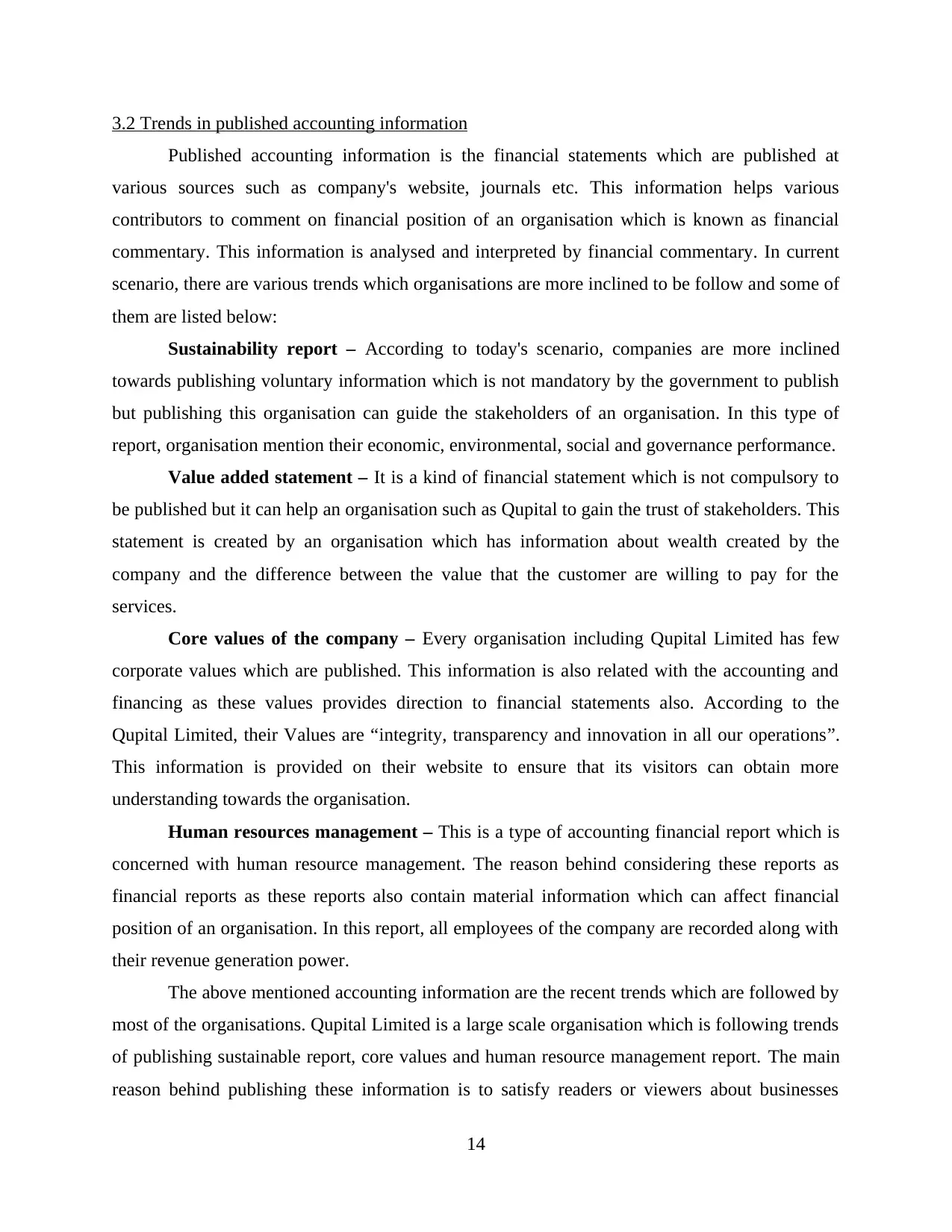
3.2 Trends in published accounting information
Published accounting information is the financial statements which are published at
various sources such as company's website, journals etc. This information helps various
contributors to comment on financial position of an organisation which is known as financial
commentary. This information is analysed and interpreted by financial commentary. In current
scenario, there are various trends which organisations are more inclined to be follow and some of
them are listed below:
Sustainability report – According to today's scenario, companies are more inclined
towards publishing voluntary information which is not mandatory by the government to publish
but publishing this organisation can guide the stakeholders of an organisation. In this type of
report, organisation mention their economic, environmental, social and governance performance.
Value added statement – It is a kind of financial statement which is not compulsory to
be published but it can help an organisation such as Qupital to gain the trust of stakeholders. This
statement is created by an organisation which has information about wealth created by the
company and the difference between the value that the customer are willing to pay for the
services.
Core values of the company – Every organisation including Qupital Limited has few
corporate values which are published. This information is also related with the accounting and
financing as these values provides direction to financial statements also. According to the
Qupital Limited, their Values are “integrity, transparency and innovation in all our operations”.
This information is provided on their website to ensure that its visitors can obtain more
understanding towards the organisation.
Human resources management – This is a type of accounting financial report which is
concerned with human resource management. The reason behind considering these reports as
financial reports as these reports also contain material information which can affect financial
position of an organisation. In this report, all employees of the company are recorded along with
their revenue generation power.
The above mentioned accounting information are the recent trends which are followed by
most of the organisations. Qupital Limited is a large scale organisation which is following trends
of publishing sustainable report, core values and human resource management report. The main
reason behind publishing these information is to satisfy readers or viewers about businesses
14
Published accounting information is the financial statements which are published at
various sources such as company's website, journals etc. This information helps various
contributors to comment on financial position of an organisation which is known as financial
commentary. This information is analysed and interpreted by financial commentary. In current
scenario, there are various trends which organisations are more inclined to be follow and some of
them are listed below:
Sustainability report – According to today's scenario, companies are more inclined
towards publishing voluntary information which is not mandatory by the government to publish
but publishing this organisation can guide the stakeholders of an organisation. In this type of
report, organisation mention their economic, environmental, social and governance performance.
Value added statement – It is a kind of financial statement which is not compulsory to
be published but it can help an organisation such as Qupital to gain the trust of stakeholders. This
statement is created by an organisation which has information about wealth created by the
company and the difference between the value that the customer are willing to pay for the
services.
Core values of the company – Every organisation including Qupital Limited has few
corporate values which are published. This information is also related with the accounting and
financing as these values provides direction to financial statements also. According to the
Qupital Limited, their Values are “integrity, transparency and innovation in all our operations”.
This information is provided on their website to ensure that its visitors can obtain more
understanding towards the organisation.
Human resources management – This is a type of accounting financial report which is
concerned with human resource management. The reason behind considering these reports as
financial reports as these reports also contain material information which can affect financial
position of an organisation. In this report, all employees of the company are recorded along with
their revenue generation power.
The above mentioned accounting information are the recent trends which are followed by
most of the organisations. Qupital Limited is a large scale organisation which is following trends
of publishing sustainable report, core values and human resource management report. The main
reason behind publishing these information is to satisfy readers or viewers about businesses
14
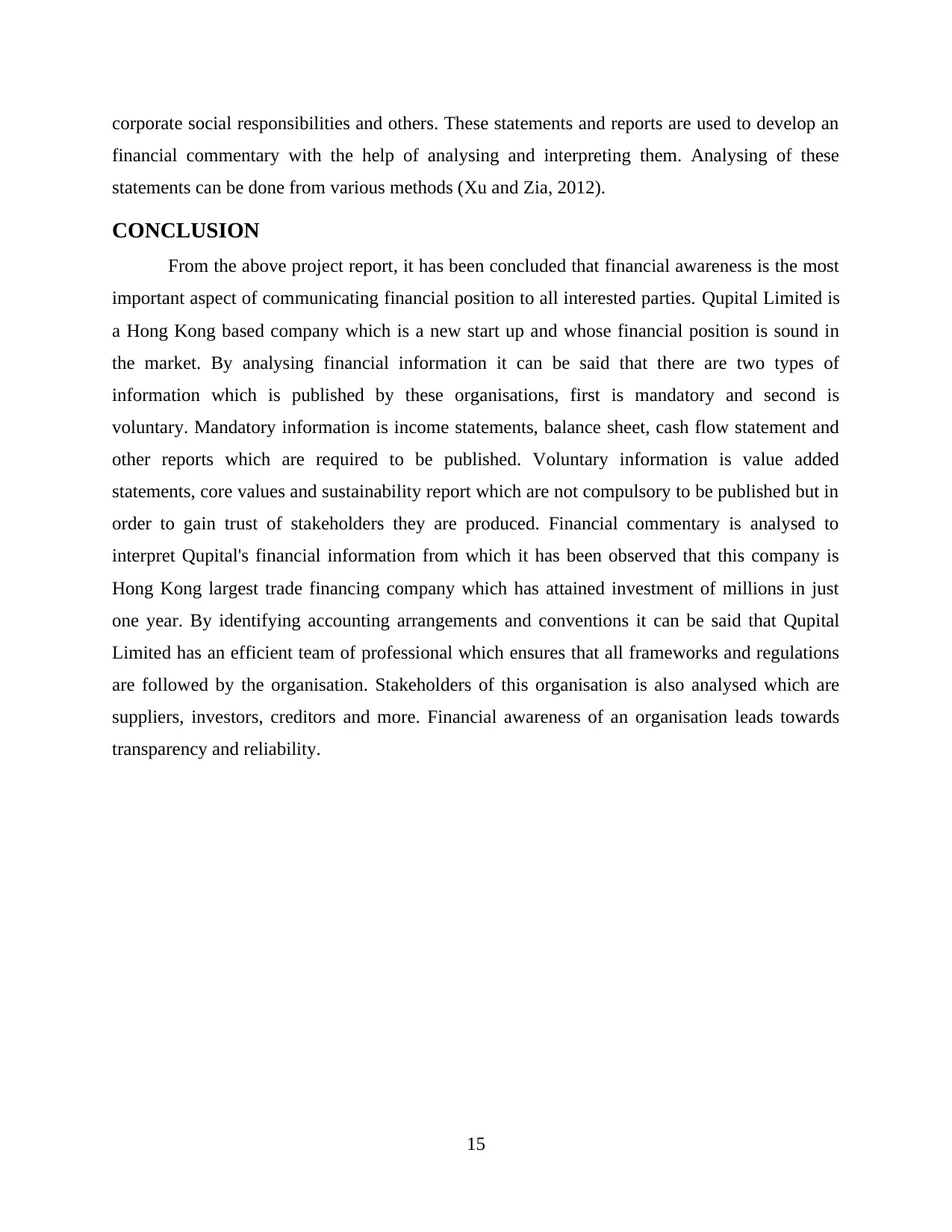
corporate social responsibilities and others. These statements and reports are used to develop an
financial commentary with the help of analysing and interpreting them. Analysing of these
statements can be done from various methods (Xu and Zia, 2012).
CONCLUSION
From the above project report, it has been concluded that financial awareness is the most
important aspect of communicating financial position to all interested parties. Qupital Limited is
a Hong Kong based company which is a new start up and whose financial position is sound in
the market. By analysing financial information it can be said that there are two types of
information which is published by these organisations, first is mandatory and second is
voluntary. Mandatory information is income statements, balance sheet, cash flow statement and
other reports which are required to be published. Voluntary information is value added
statements, core values and sustainability report which are not compulsory to be published but in
order to gain trust of stakeholders they are produced. Financial commentary is analysed to
interpret Qupital's financial information from which it has been observed that this company is
Hong Kong largest trade financing company which has attained investment of millions in just
one year. By identifying accounting arrangements and conventions it can be said that Qupital
Limited has an efficient team of professional which ensures that all frameworks and regulations
are followed by the organisation. Stakeholders of this organisation is also analysed which are
suppliers, investors, creditors and more. Financial awareness of an organisation leads towards
transparency and reliability.
15
financial commentary with the help of analysing and interpreting them. Analysing of these
statements can be done from various methods (Xu and Zia, 2012).
CONCLUSION
From the above project report, it has been concluded that financial awareness is the most
important aspect of communicating financial position to all interested parties. Qupital Limited is
a Hong Kong based company which is a new start up and whose financial position is sound in
the market. By analysing financial information it can be said that there are two types of
information which is published by these organisations, first is mandatory and second is
voluntary. Mandatory information is income statements, balance sheet, cash flow statement and
other reports which are required to be published. Voluntary information is value added
statements, core values and sustainability report which are not compulsory to be published but in
order to gain trust of stakeholders they are produced. Financial commentary is analysed to
interpret Qupital's financial information from which it has been observed that this company is
Hong Kong largest trade financing company which has attained investment of millions in just
one year. By identifying accounting arrangements and conventions it can be said that Qupital
Limited has an efficient team of professional which ensures that all frameworks and regulations
are followed by the organisation. Stakeholders of this organisation is also analysed which are
suppliers, investors, creditors and more. Financial awareness of an organisation leads towards
transparency and reliability.
15
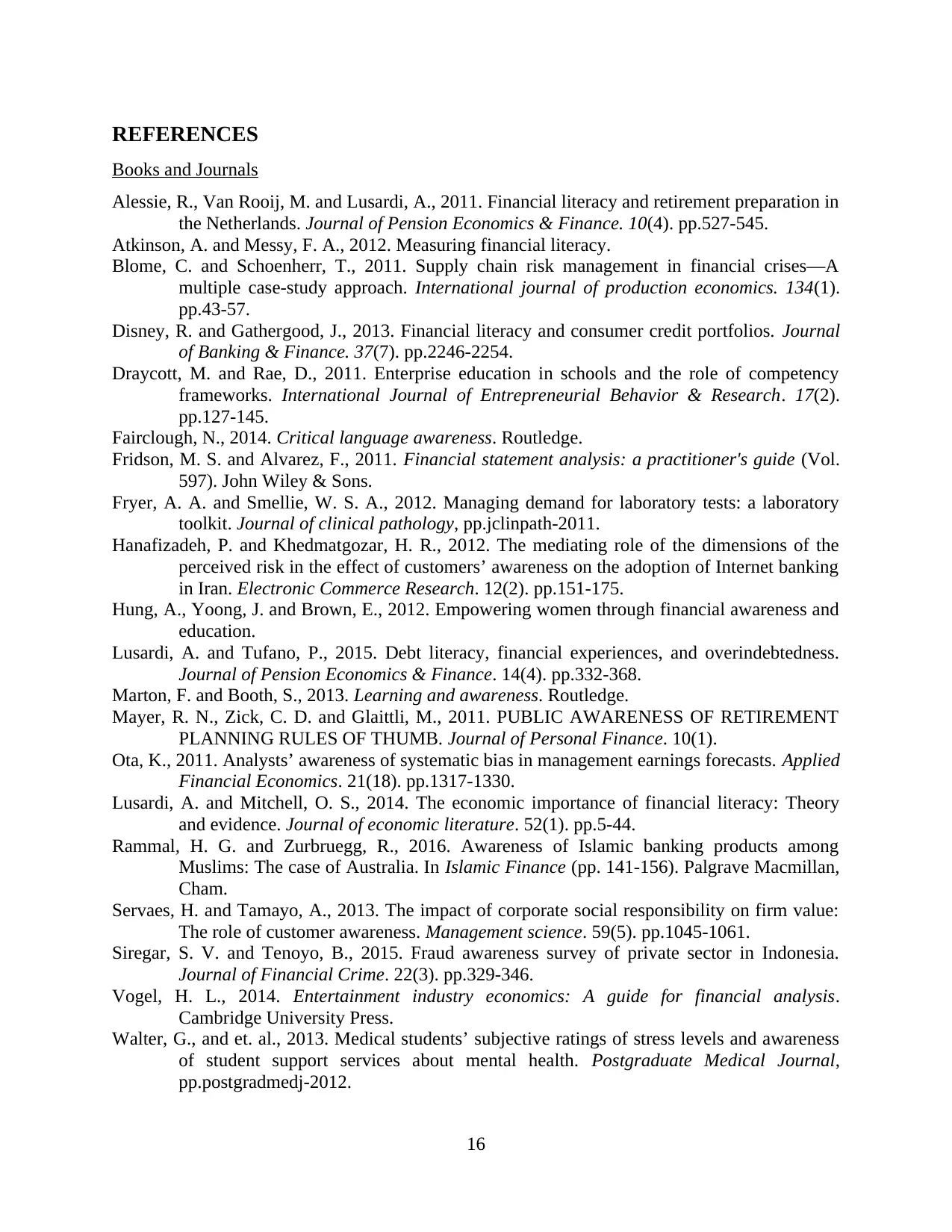
REFERENCES
Books and Journals
Alessie, R., Van Rooij, M. and Lusardi, A., 2011. Financial literacy and retirement preparation in
the Netherlands. Journal of Pension Economics & Finance. 10(4). pp.527-545.
Atkinson, A. and Messy, F. A., 2012. Measuring financial literacy.
Blome, C. and Schoenherr, T., 2011. Supply chain risk management in financial crises—A
multiple case-study approach. International journal of production economics. 134(1).
pp.43-57.
Disney, R. and Gathergood, J., 2013. Financial literacy and consumer credit portfolios. Journal
of Banking & Finance. 37(7). pp.2246-2254.
Draycott, M. and Rae, D., 2011. Enterprise education in schools and the role of competency
frameworks. International Journal of Entrepreneurial Behavior & Research. 17(2).
pp.127-145.
Fairclough, N., 2014. Critical language awareness. Routledge.
Fridson, M. S. and Alvarez, F., 2011. Financial statement analysis: a practitioner's guide (Vol.
597). John Wiley & Sons.
Fryer, A. A. and Smellie, W. S. A., 2012. Managing demand for laboratory tests: a laboratory
toolkit. Journal of clinical pathology, pp.jclinpath-2011.
Hanafizadeh, P. and Khedmatgozar, H. R., 2012. The mediating role of the dimensions of the
perceived risk in the effect of customers’ awareness on the adoption of Internet banking
in Iran. Electronic Commerce Research. 12(2). pp.151-175.
Hung, A., Yoong, J. and Brown, E., 2012. Empowering women through financial awareness and
education.
Lusardi, A. and Tufano, P., 2015. Debt literacy, financial experiences, and overindebtedness.
Journal of Pension Economics & Finance. 14(4). pp.332-368.
Marton, F. and Booth, S., 2013. Learning and awareness. Routledge.
Mayer, R. N., Zick, C. D. and Glaittli, M., 2011. PUBLIC AWARENESS OF RETIREMENT
PLANNING RULES OF THUMB. Journal of Personal Finance. 10(1).
Ota, K., 2011. Analysts’ awareness of systematic bias in management earnings forecasts. Applied
Financial Economics. 21(18). pp.1317-1330.
Lusardi, A. and Mitchell, O. S., 2014. The economic importance of financial literacy: Theory
and evidence. Journal of economic literature. 52(1). pp.5-44.
Rammal, H. G. and Zurbruegg, R., 2016. Awareness of Islamic banking products among
Muslims: The case of Australia. In Islamic Finance (pp. 141-156). Palgrave Macmillan,
Cham.
Servaes, H. and Tamayo, A., 2013. The impact of corporate social responsibility on firm value:
The role of customer awareness. Management science. 59(5). pp.1045-1061.
Siregar, S. V. and Tenoyo, B., 2015. Fraud awareness survey of private sector in Indonesia.
Journal of Financial Crime. 22(3). pp.329-346.
Vogel, H. L., 2014. Entertainment industry economics: A guide for financial analysis.
Cambridge University Press.
Walter, G., and et. al., 2013. Medical students’ subjective ratings of stress levels and awareness
of student support services about mental health. Postgraduate Medical Journal,
pp.postgradmedj-2012.
16
Books and Journals
Alessie, R., Van Rooij, M. and Lusardi, A., 2011. Financial literacy and retirement preparation in
the Netherlands. Journal of Pension Economics & Finance. 10(4). pp.527-545.
Atkinson, A. and Messy, F. A., 2012. Measuring financial literacy.
Blome, C. and Schoenherr, T., 2011. Supply chain risk management in financial crises—A
multiple case-study approach. International journal of production economics. 134(1).
pp.43-57.
Disney, R. and Gathergood, J., 2013. Financial literacy and consumer credit portfolios. Journal
of Banking & Finance. 37(7). pp.2246-2254.
Draycott, M. and Rae, D., 2011. Enterprise education in schools and the role of competency
frameworks. International Journal of Entrepreneurial Behavior & Research. 17(2).
pp.127-145.
Fairclough, N., 2014. Critical language awareness. Routledge.
Fridson, M. S. and Alvarez, F., 2011. Financial statement analysis: a practitioner's guide (Vol.
597). John Wiley & Sons.
Fryer, A. A. and Smellie, W. S. A., 2012. Managing demand for laboratory tests: a laboratory
toolkit. Journal of clinical pathology, pp.jclinpath-2011.
Hanafizadeh, P. and Khedmatgozar, H. R., 2012. The mediating role of the dimensions of the
perceived risk in the effect of customers’ awareness on the adoption of Internet banking
in Iran. Electronic Commerce Research. 12(2). pp.151-175.
Hung, A., Yoong, J. and Brown, E., 2012. Empowering women through financial awareness and
education.
Lusardi, A. and Tufano, P., 2015. Debt literacy, financial experiences, and overindebtedness.
Journal of Pension Economics & Finance. 14(4). pp.332-368.
Marton, F. and Booth, S., 2013. Learning and awareness. Routledge.
Mayer, R. N., Zick, C. D. and Glaittli, M., 2011. PUBLIC AWARENESS OF RETIREMENT
PLANNING RULES OF THUMB. Journal of Personal Finance. 10(1).
Ota, K., 2011. Analysts’ awareness of systematic bias in management earnings forecasts. Applied
Financial Economics. 21(18). pp.1317-1330.
Lusardi, A. and Mitchell, O. S., 2014. The economic importance of financial literacy: Theory
and evidence. Journal of economic literature. 52(1). pp.5-44.
Rammal, H. G. and Zurbruegg, R., 2016. Awareness of Islamic banking products among
Muslims: The case of Australia. In Islamic Finance (pp. 141-156). Palgrave Macmillan,
Cham.
Servaes, H. and Tamayo, A., 2013. The impact of corporate social responsibility on firm value:
The role of customer awareness. Management science. 59(5). pp.1045-1061.
Siregar, S. V. and Tenoyo, B., 2015. Fraud awareness survey of private sector in Indonesia.
Journal of Financial Crime. 22(3). pp.329-346.
Vogel, H. L., 2014. Entertainment industry economics: A guide for financial analysis.
Cambridge University Press.
Walter, G., and et. al., 2013. Medical students’ subjective ratings of stress levels and awareness
of student support services about mental health. Postgraduate Medical Journal,
pp.postgradmedj-2012.
16
Paraphrase This Document
Need a fresh take? Get an instant paraphrase of this document with our AI Paraphraser
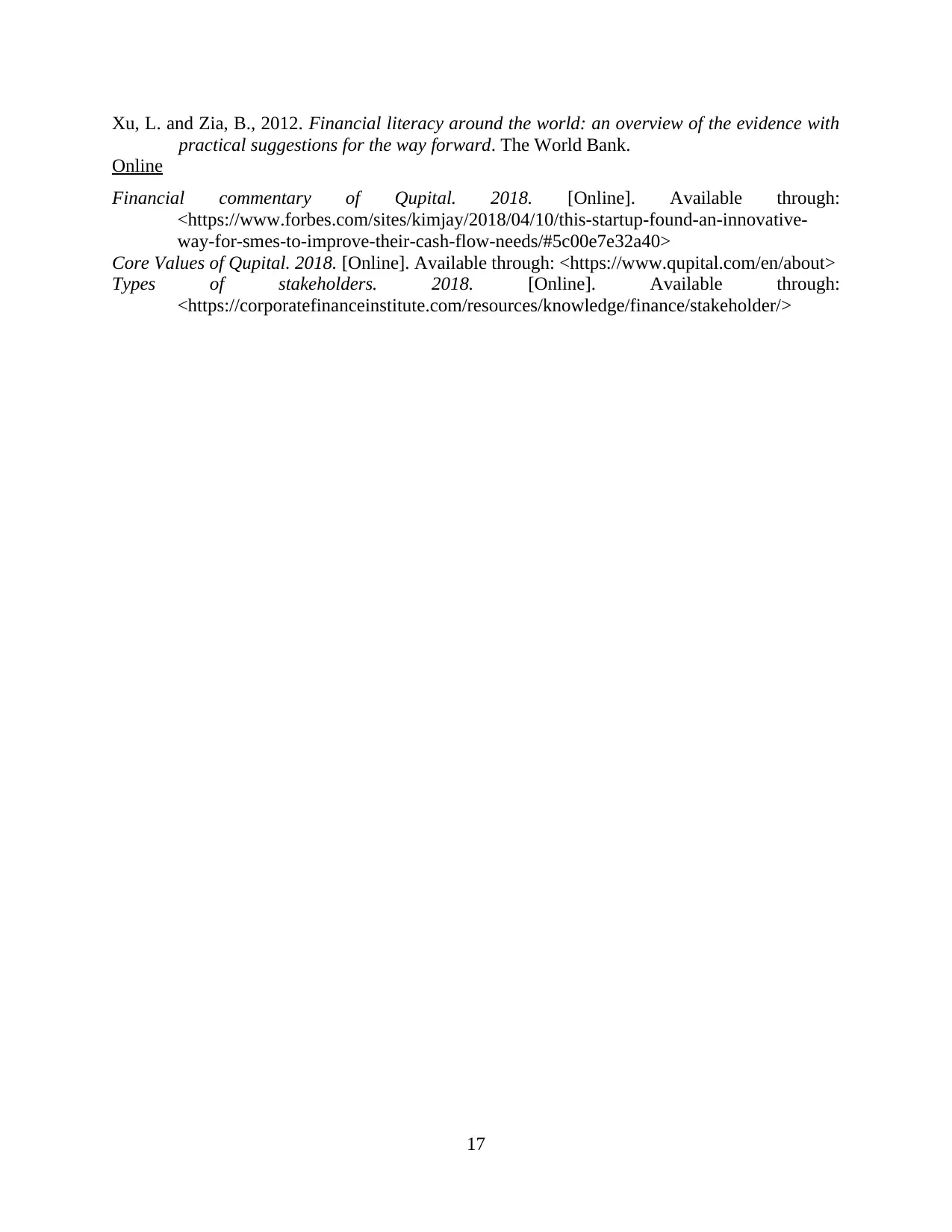
Xu, L. and Zia, B., 2012. Financial literacy around the world: an overview of the evidence with
practical suggestions for the way forward. The World Bank.
Online
Financial commentary of Qupital. 2018. [Online]. Available through:
<https://www.forbes.com/sites/kimjay/2018/04/10/this-startup-found-an-innovative-
way-for-smes-to-improve-their-cash-flow-needs/#5c00e7e32a40>
Core Values of Qupital. 2018. [Online]. Available through: <https://www.qupital.com/en/about>
Types of stakeholders. 2018. [Online]. Available through:
<https://corporatefinanceinstitute.com/resources/knowledge/finance/stakeholder/>
17
practical suggestions for the way forward. The World Bank.
Online
Financial commentary of Qupital. 2018. [Online]. Available through:
<https://www.forbes.com/sites/kimjay/2018/04/10/this-startup-found-an-innovative-
way-for-smes-to-improve-their-cash-flow-needs/#5c00e7e32a40>
Core Values of Qupital. 2018. [Online]. Available through: <https://www.qupital.com/en/about>
Types of stakeholders. 2018. [Online]. Available through:
<https://corporatefinanceinstitute.com/resources/knowledge/finance/stakeholder/>
17
1 out of 20
Related Documents
Your All-in-One AI-Powered Toolkit for Academic Success.
+13062052269
info@desklib.com
Available 24*7 on WhatsApp / Email
![[object Object]](/_next/static/media/star-bottom.7253800d.svg)
Unlock your academic potential
© 2024 | Zucol Services PVT LTD | All rights reserved.





